Mammals of Mexico on:
[Wikipedia]
[Google]
[Amazon]
This is a list of the native wild mammal species recorded in

 Sirenia is an order of fully aquatic, herbivorous mammals that inhabit rivers, estuaries, coastal marine waters, swamps, and marine wetlands. All four species are endangered. They evolved about 50 million years ago, and their closest living relatives are
Sirenia is an order of fully aquatic, herbivorous mammals that inhabit rivers, estuaries, coastal marine waters, swamps, and marine wetlands. All four species are endangered. They evolved about 50 million years ago, and their closest living relatives are
 Armadillos are small mammals with a bony armored shell. Two of twenty-one extant species are present in Mexico; the remainder are only found in South America, where they originated. Their much larger relatives, the
Armadillos are small mammals with a bony armored shell. Two of twenty-one extant species are present in Mexico; the remainder are only found in South America, where they originated. Their much larger relatives, the

 The order Pilosa is extant only in the Americas and includes the
The order Pilosa is extant only in the Americas and includes the





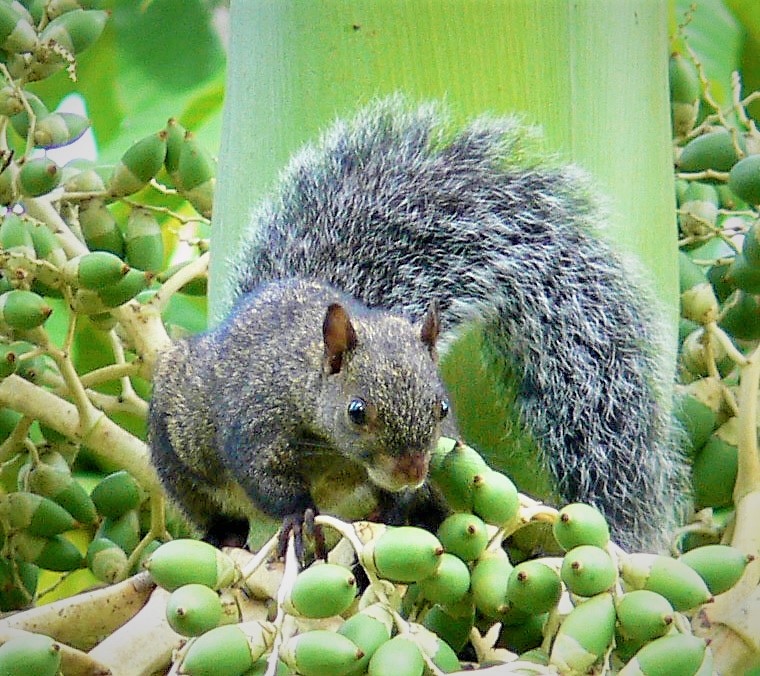




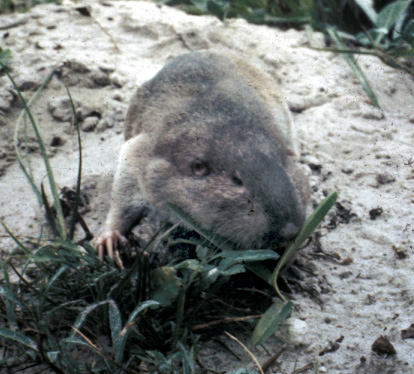
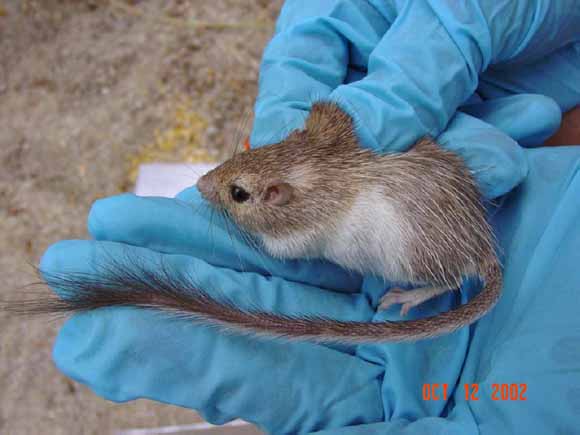



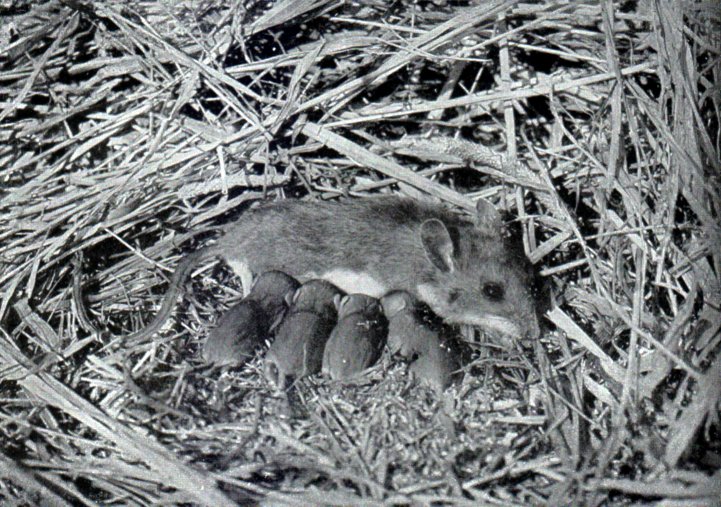



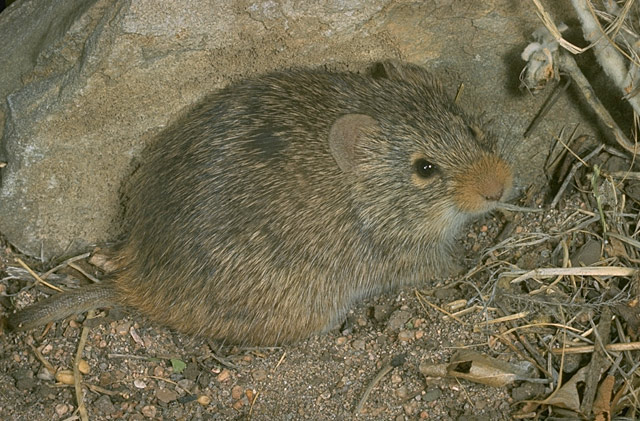 Rodents make up the largest order of mammals, with over 40% of mammalian species. They have two
Rodents make up the largest order of mammals, with over 40% of mammalian species. They have two

 Eulipotyphlans are insectivorous mammals. Shrews and solenodons closely resemble mice, hedgehogs carry spines, while Mole (animal), moles are stout-bodied burrowers. In the Americas, moles are not present south of the northernmost tier of Mexican states, where they are rare.
*Family: Soricidae (shrews)
**Subfamily: Soricinae
***Tribe: Blarinini
****Genus: ''Cryptotis''
***** Central Mexican broad-clawed shrew, ''Cryptotis alticola'' DD
***** Goldman's broad-clawed shrew, ''Cryptotis goldmani'' LC
***** Goodwin's broad-clawed shrew, ''Cryptotis goodwini'' LC
***** Guatemalan broad-clawed shrew, ''Cryptotis griseoventris'' EN
***** Big Mexican small-eared shrew, ''Cryptotis magna'' VU
***** Yucatan small-eared shrew, ''Cryptotis mayensis'' LC
***** Merriam's small-eared shrew, ''Cryptotis merriami'' LC
***** Mexican small-eared shrew, ''Cryptotis mexicana'' LC
***** Nelson's small-eared shrew, ''Cryptotis nelsoni'' CR
***** Grizzled Mexican small-eared shrew, ''Cryptotis obscura'' LC
***** North American least shrew, ''Cryptotis parva'' LC
***** Oaxacan broad-clawed shrew, ''Cryptotis peregrina'' DD
***** Phillips' small-eared shrew, ''Cryptotis phillipsii'' VU
***** Tropical small-eared shrew, ''Cryptotis tropicalis'' DD
***Tribe: Notiosoricini
****Genus: ''Megasorex''
***** Mexican shrew, ''Megasorex gigas'' LC
****Genus: ''Notiosorex''
***** Cockrum's gray shrew, ''Notiosorex cockrumi'' LC
***** Crawford's gray shrew, ''Notiosorex crawfordi'' LC
***** Large-eared gray shrew, ''Notiosorex evotis'' LC
***** Villa's gray shrew, ''Notiosorex villai'' VU
***Tribe: Soricini
****Genus: ''Sorex''
***** Arizona shrew, ''Sorex arizonae'' LC
***** Zacatecas shrew, ''Sorex emarginatus'' LC
***** ''Sorex ixtlanensis'' DD
***** Large-toothed shrew, ''Sorex macrodon'' VU
***** ''Sorex mediopua'' LC
***** Carmen Mountain shrew, ''Sorex milleri'' VU
***** Montane shrew, ''Sorex monticolus'' LC
***** Mexican long-tailed shrew, ''Sorex oreopolus'' LC
***** Orizaba long-tailed shrew, ''Sorex orizabae'' LC
***** Ornate shrew, ''Sorex ornatus'' LC
***** Saussure's shrew, ''Sorex saussurei'' LC
***** Sclater's shrew, ''Sorex sclateri'' CR
***** San Cristobal shrew, ''Sorex stizodon'' CR
***** Chestnut-bellied shrew, ''Sorex ventralis'' LC
***** Veracruz shrew, ''Sorex veraecrucis'' LC
***** Verapaz shrew, ''Sorex veraepacis'' LC
*Family: Talpidae (moles)
**Subfamily: Scalopinae
***Tribe: Scalopini
****Genus: ''Scalopus''
***** Eastern mole, ''Scalopus aquaticus'' LC
****Genus: ''Scapanus''
***** Southern broad-footed mole, ''Scapanus occultus''
***** Mexican mole, ''Scapanus anthonyi''
Eulipotyphlans are insectivorous mammals. Shrews and solenodons closely resemble mice, hedgehogs carry spines, while Mole (animal), moles are stout-bodied burrowers. In the Americas, moles are not present south of the northernmost tier of Mexican states, where they are rare.
*Family: Soricidae (shrews)
**Subfamily: Soricinae
***Tribe: Blarinini
****Genus: ''Cryptotis''
***** Central Mexican broad-clawed shrew, ''Cryptotis alticola'' DD
***** Goldman's broad-clawed shrew, ''Cryptotis goldmani'' LC
***** Goodwin's broad-clawed shrew, ''Cryptotis goodwini'' LC
***** Guatemalan broad-clawed shrew, ''Cryptotis griseoventris'' EN
***** Big Mexican small-eared shrew, ''Cryptotis magna'' VU
***** Yucatan small-eared shrew, ''Cryptotis mayensis'' LC
***** Merriam's small-eared shrew, ''Cryptotis merriami'' LC
***** Mexican small-eared shrew, ''Cryptotis mexicana'' LC
***** Nelson's small-eared shrew, ''Cryptotis nelsoni'' CR
***** Grizzled Mexican small-eared shrew, ''Cryptotis obscura'' LC
***** North American least shrew, ''Cryptotis parva'' LC
***** Oaxacan broad-clawed shrew, ''Cryptotis peregrina'' DD
***** Phillips' small-eared shrew, ''Cryptotis phillipsii'' VU
***** Tropical small-eared shrew, ''Cryptotis tropicalis'' DD
***Tribe: Notiosoricini
****Genus: ''Megasorex''
***** Mexican shrew, ''Megasorex gigas'' LC
****Genus: ''Notiosorex''
***** Cockrum's gray shrew, ''Notiosorex cockrumi'' LC
***** Crawford's gray shrew, ''Notiosorex crawfordi'' LC
***** Large-eared gray shrew, ''Notiosorex evotis'' LC
***** Villa's gray shrew, ''Notiosorex villai'' VU
***Tribe: Soricini
****Genus: ''Sorex''
***** Arizona shrew, ''Sorex arizonae'' LC
***** Zacatecas shrew, ''Sorex emarginatus'' LC
***** ''Sorex ixtlanensis'' DD
***** Large-toothed shrew, ''Sorex macrodon'' VU
***** ''Sorex mediopua'' LC
***** Carmen Mountain shrew, ''Sorex milleri'' VU
***** Montane shrew, ''Sorex monticolus'' LC
***** Mexican long-tailed shrew, ''Sorex oreopolus'' LC
***** Orizaba long-tailed shrew, ''Sorex orizabae'' LC
***** Ornate shrew, ''Sorex ornatus'' LC
***** Saussure's shrew, ''Sorex saussurei'' LC
***** Sclater's shrew, ''Sorex sclateri'' CR
***** San Cristobal shrew, ''Sorex stizodon'' CR
***** Chestnut-bellied shrew, ''Sorex ventralis'' LC
***** Veracruz shrew, ''Sorex veraecrucis'' LC
***** Verapaz shrew, ''Sorex veraepacis'' LC
*Family: Talpidae (moles)
**Subfamily: Scalopinae
***Tribe: Scalopini
****Genus: ''Scalopus''
***** Eastern mole, ''Scalopus aquaticus'' LC
****Genus: ''Scapanus''
***** Southern broad-footed mole, ''Scapanus occultus''
***** Mexican mole, ''Scapanus anthonyi''



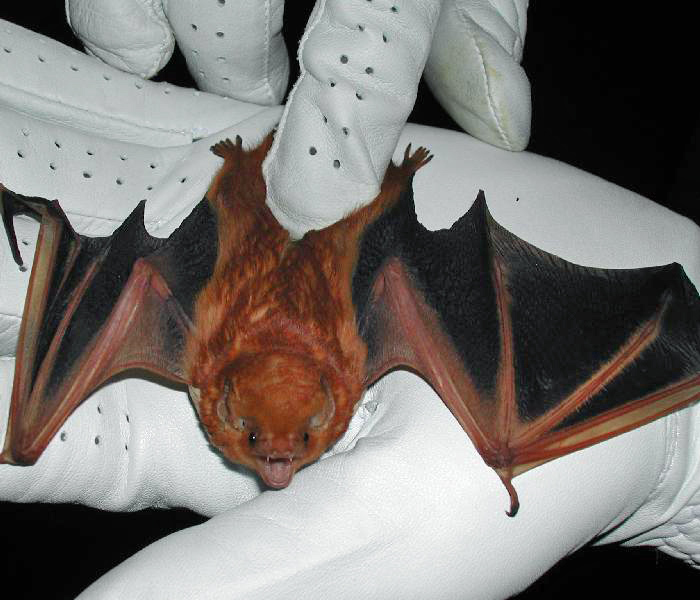
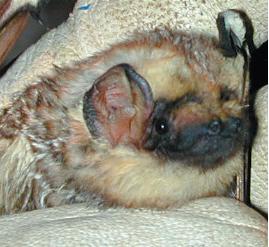
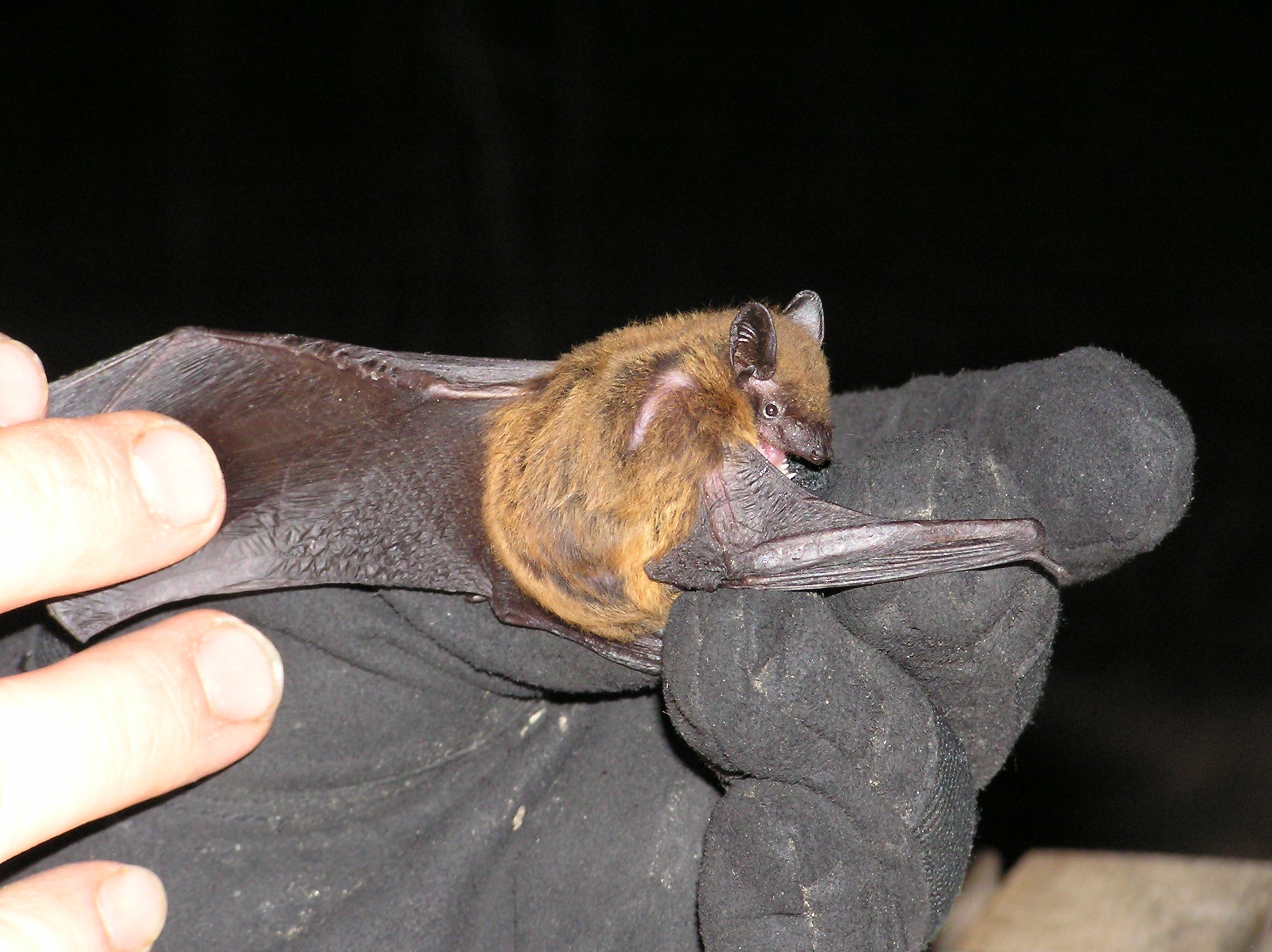
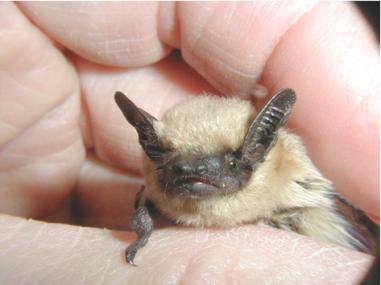

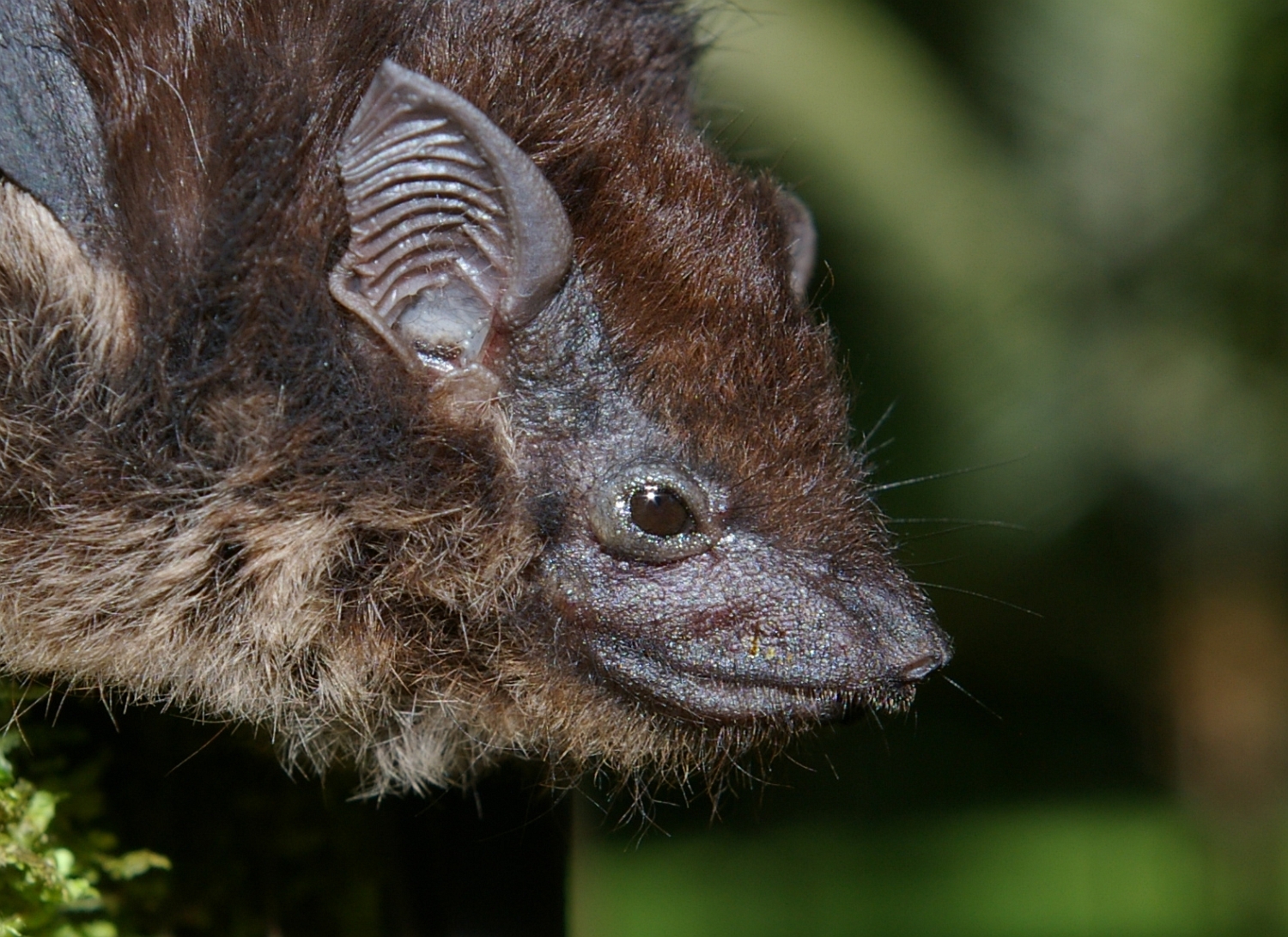
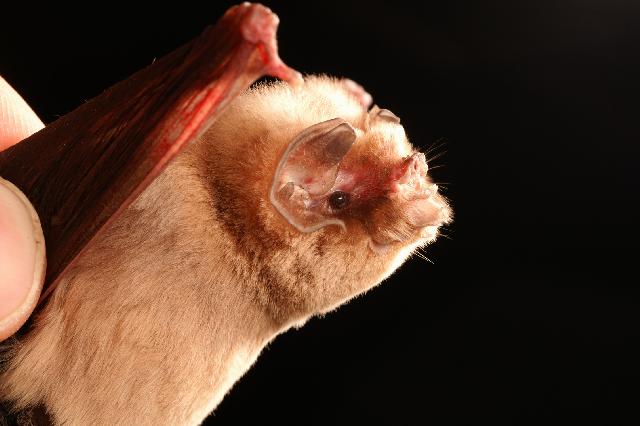

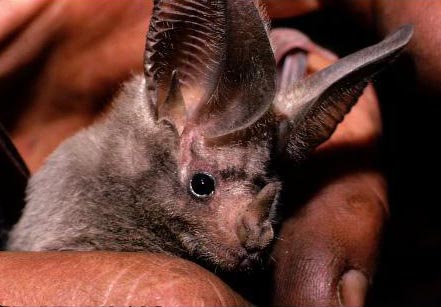


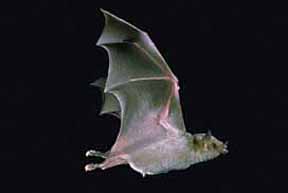
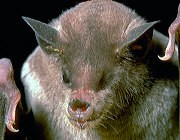



 The bats' most distinguishing feature is that their forelimbs are developed as wings, making them the only mammals capable of flight. Bat species account for about 20% of all mammals.
*Family: Noctilionidae
**Genus: ''Noctilio''
*** Lesser bulldog bat, ''Noctilio albiventris'' LC
*** Greater bulldog bat, ''Noctilio leporinus'' LC
*Family: Vespertilionidae
**Subfamily: Myotinae
***Genus: ''Lasionycteris''
**** Silver-haired bat, ''Lasionycteris noctivagans'' LC
***Genus: ''Myotis''
**** Silver-tipped myotis, ''Myotis albescens'' LC
**** Southwestern myotis, ''Myotis auriculus'' LC
**** California myotis, ''Myotis californicus'' LC
**** Western small-footed myotis, ''Myotis ciliolabrum'' LC
**** Elegant myotis, ''Myotis elegans'' LC
**** Long-eared myotis, ''Myotis evotis'' LC
**** Findley's myotis, ''Myotis findleyi'' EN
**** Cinnamon myotis, ''Myotis fortidens'' LC
**** Hairy-legged myotis, ''Myotis keaysi'' LC
**** Little brown bat, ''Myotis lucifugus'' LC
**** Dark-nosed small-footed myotis, ''Myotis melanorhinus'' LC
**** Black myotis, ''Myotis nigricans'' LC
**** Arizona myotis, ''Myotis occultus'' LC
**** Peninsular myotis, ''Myotis peninsularis'' EN
**** Flat-headed myotis, ''Myotis planiceps'' EN
**** Fringed myotis, ''Myotis thysanodes'' LC
**** Cave myotis, ''Myotis velifer'' LC
**** Fish-eating bat, ''Myotis vivesi'' VU
**** Long-legged myotis, ''Myotis volans'' LC
**** Yuma myotis, ''Myotis yumanensis'' LC
**Subfamily: Vespertilioninae
***Genus: ''Antrozous''
**** Pallid bat, ''Antrozous pallidus'' LC
***Genus: ''Bauerus''
**** Van Gelder's bat, ''Bauerus dubiaquercus'' NT
***Genus: ''Corynorhinus''
**** Mexican big-eared bat, ''Corynorhinus mexicanus'' NT
**** Townsend's big-eared bat, ''Corynorhinus townsendii'' LC
***Genus: ''Eptesicus''
**** Brazilian brown bat, ''Eptesicus brasiliensis'' LC
**** Argentine brown bat, ''Eptesicus furinalis'' LC
**** Big brown bat, ''Eptesicus fuscus'' LC
***Genus: ''Euderma''
**** Spotted bat, ''Euderma maculatum'' LC
***Genus: ''Idionycteris''
**** Allen's big-eared bat, ''Idionycteris phyllotis'' LC
***Genus: ''Lasiurus''
**** Desert red bat, ''Lasiurus blossevillii'' LC
**** Eastern red bat, ''Lasiurus borealis'' LC
**** Hoary bat, ''Lasiurus cinereus'' LC
**** Southern yellow bat, ''Lasiurus ega'' LC
**** Northern yellow bat, ''Lasiurus intermedius'' LC
**** Seminole bat, ''Lasiurus seminolus'' LC
**** Western yellow bat, ''Lasiurus xanthinus'' LC
***Genus: ''Nycticeius''
**** Evening bat, ''Nycticeius humeralis'' LC
***Genus: ''Pipistrellus''
**** Western pipistrelle, ''Pipistrellus hesperus'' LC
**** Eastern pipistrelle, ''Pipistrellus subflavus'' LC
***Genus: ''Rhogeessa''
**** Yucatan yellow bat, ''Rhogeessa aeneus'' LC
**** Allen's yellow bat, ''Rhogeessa alleni'' LC
**** Genoways's yellow bat, ''Rhogeessa genowaysi'' EN
**** Slender yellow bat, ''Rhogeessa gracilis'' LC
**** Least yellow bat, ''Rhogeessa mira'' VU
**** Little yellow bat, ''Rhogeessa parvula'' LC
**** Black-winged little yellow bat, ''Rhogeessa tumida'' LC
*Family: Molossidae
**Genus: ''Cynomops''
*** Mexican dog-faced bat, ''Cynomops mexicanus'' LC
**Genus: ''Eumops''
*** Black bonneted bat, ''Eumops auripendulus'' LC
*** Dwarf bonneted bat, ''Eumops bonariensis'' LC
*** Wagner's bonneted bat, ''Eumops glaucinus'' LC
*** Sanborn's bonneted bat, ''Eumops hansae'' LC
*** Western mastiff bat, ''Eumops perotis'' LC
*** Underwood's bonneted bat, ''Eumops underwoodi'' LC
**Genus: ''Molossus (bat), Molossus''
*** Aztec mastiff bat, ''Molossus aztecus'' LC
*** Coiban mastiff bat, ''Molossus coibensis'' LC
*** Velvety free-tailed bat, ''Molossus molossus'' LC
*** Miller's mastiff bat, ''Molossus pretiosus'' LC
*** Black mastiff bat, ''Molossus rufus'' LC
*** Sinaloan mastiff bat, ''Molossus sinaloae'' LC
**Genus: ''Nyctinomops''
*** Peale's free-tailed bat, ''Nyctinomops aurispinosus'' LC
*** Pocketed free-tailed bat, ''Nyctinomops femorosaccus'' LC
*** Broad-eared bat, ''Nyctinomops laticaudatus'' LC
*** Big free-tailed bat, ''Nyctinomops macrotis'' LC
**Genus: ''Promops''
*** Big crested mastiff bat, ''Promops centralis'' LC
**Genus: ''Tadarida''
*** Mexican free-tailed bat, ''Tadarida brasiliensis'' LC
*Family: Emballonuridae
**Genus: ''Balantiopteryx''
*** Thomas's sac-winged bat, ''Balantiopteryx io'' VU
*** Gray sac-winged bat, ''Balantiopteryx plicata'' LC
**Genus: ''Centronycteris''
*** Thomas's shaggy bat, ''Centronycteris centralis'' LC
**Genus: ''Diclidurus''
*** Northern ghost bat, ''Diclidurus albus'' LC
**Genus: ''Peropteryx''
*** Greater dog-like bat, ''Peropteryx kappleri'' LC
*** Lesser doglike bat, ''Peropteryx macrotis'' LC
**Genus: ''Rhynchonycteris''
*** Proboscis bat, ''Rhynchonycteris naso'' LC
**Genus: ''Saccopteryx''
*** Greater sac-winged bat, ''Saccopteryx bilineata'' LC
*** Lesser sac-winged bat, ''Saccopteryx leptura'' LC
*Family: Mormoopidae
**Genus: ''Mormoops''
*** Ghost-faced bat, ''Mormoops megalophylla'' LC
**Genus: ''Pteronotus''
*** Davy's naked-backed bat, ''Pteronotus davyi'' LC
*** Big naked-backed bat, ''Pteronotus gymnonotus'' LC
*** Parnell's mustached bat, ''Pteronotus parnellii'' LC
*** Wagner's mustached bat, ''Pteronotus personatus'' LC
*Family: Phyllostomidae
**Subfamily: Phyllostominae
***Genus: ''Chrotopterus''
**** Big-eared woolly bat, ''Chrotopterus auritus'' LC
***Genus: ''Glyphonycteris''
**** Tricolored big-eared bat, ''Glyphonycteris sylvestris'' LC
***Genus: ''Lampronycteris''
**** Yellow-throated big-eared bat, ''Lampronycteris brachyotis'' LC
***Genus: ''Lonchorhina''
**** Tomes's sword-nosed bat, ''Lonchorhina aurita'' LC
***Genus: ''Lophostoma''
**** Pygmy round-eared bat, ''Lophostoma brasiliense'' LC
**** Davis's round-eared bat, ''Lophostoma evotis'' LC
***Genus: ''Long-legged bat, Macrophyllum''
**** Long-legged bat, ''Macrophyllum macrophyllum'' LC
***Genus: ''Macrotus''
**** California leaf-nosed bat, ''Macrotus californicus'' LC
**** Waterhouse's leaf-nosed bat, ''Macrotus waterhousii'' LC
***Genus: ''Micronycteris''
**** Common big-eared bat, ''Micronycteris microtis'' LC
**** Schmidts's big-eared bat, ''Micronycteris schmidtorum'' LC
***Genus: ''Mimon''
**** Cozumelan golden bat, ''Mimon cozumelae'' LC
**** Striped hairy-nosed bat, ''Mimon crenulatum'' LC
***Genus: ''Phylloderma''
**** Pale-faced bat, ''Phylloderma stenops'' LC
***Genus: ''Phyllostomus''
**** Pale spear-nosed bat, ''Phyllostomus discolor'' LC
***Genus: ''Tonatia''
**** Stripe-headed round-eared bat, ''Tonatia saurophila'' LC
***Genus: ''Trachops''
**** Fringe-lipped bat, ''Trachops cirrhosus'' LC
***Genus: ''Trinycteris''
**** Niceforo's big-eared bat, ''Trinycteris nicefori'' LC
***Genus: ''Vampyrum''
**** Spectral bat, ''Vampyrum spectrum'' NT
**Subfamily: Glossophaginae
***Genus: ''Anoura''
**** Geoffroy's tailless bat, ''Anoura geoffroyi'' LC
***Genus: ''Choeroniscus''
**** Godman's long-tailed bat, ''Choeroniscus godmani'' LC
***Genus: ''Choeronycteris''
**** Mexican long-tongued bat, ''Choeronycteris mexicana'' NT
***Genus: ''Glossophaga''
**** Commissaris's long-tongued bat, ''Glossophaga commissarisi'' LC
**** Gray long-tongued bat, ''Glossophaga leachii'' LC
**** Western long-tongued bat, ''Glossophaga morenoi'' LC
**** Pallas's long-tongued bat, ''Glossophaga soricina'' LC
***Genus: ''Hylonycteris''
**** Underwood's long-tongued bat, ''Hylonycteris underwoodi'' LC
***Genus: ''Leptonycteris''
**** Greater long-nosed bat, ''Leptonycteris nivalis'' EN
**** Lesser long-nosed bat, ''Leptonycteris yerbabuenae'' VU
***Genus: ''Lichonycteris''
**** Dark long-tongued bat, ''Lichonycteris obscura'' LC
***Genus: ''Musonycteris''
**** Banana bat, ''Musonycteris harrisoni'' VU
**Subfamily: Carolliinae
***Genus: ''Carollia''
**** Seba's short-tailed bat, ''Carollia perspicillata'' LC
**** Sowell's short-tailed bat, ''Carollia sowelli'' LC
**** Gray short-tailed bat, ''Carollia subrufa'' LC
**Subfamily: Stenodermatinae
***Genus: ''Artibeus''
**** Hairy fruit-eating bat, ''Artibeus hirsutus'' LC
**** Jamaican fruit bat, ''Artibeus jamaicensis'' LC
**** Great fruit-eating bat, ''Artibeus lituratus'' LC
***Genus: ''Wrinkle-faced bat, Centurio''
**** Wrinkle-faced bat, ''Centurio senex'' LC
***Genus: ''Chiroderma''
**** Salvin's big-eyed bat, ''Chiroderma salvini'' LC
**** Hairy big-eyed bat, ''Chiroderma villosum'' LC
***Genus: ''Dermanura''
**** Aztec fruit-eating bat, ''Dermanura azteca'' LC
**** Pygmy fruit-eating bat, ''Dermanura phaeotis'' LC
**** Toltec fruit-eating bat, ''Dermanura tolteca'' LC
**** Thomas's fruit-eating bat, ''Dermanura watsoni'' LC
***Genus: ''Enchisthenes''
**** Velvety fruit-eating bat, ''Enchisthenes hartii'' LC
***Genus: ''Platyrrhinus''
**** Heller's broad-nosed bat, ''Platyrrhinus helleri'' LC
***Genus: ''Sturnira''
**** Little yellow-shouldered bat, ''Sturnira lilium'' LC
**** Highland yellow-shouldered bat, ''Sturnira ludovici'' LC
***Genus: ''Uroderma''
**** Tent-making bat, ''Uroderma bilobatum'' LC
**** Brown tent-making bat, ''Uroderma magnirostrum'' LC
***Genus: ''Vampyressa''
**** Northern little yellow-eared bat, ''Vampyressa thyone'' LC
***Genus: ''Vampyrodes''
**** Great stripe-faced bat, ''Vampyrodes caraccioli'' LC
**Subfamily: Desmodontinae
***Genus: ''Desmodus''
**** Common vampire bat, ''Desmodus rotundus'' LC
***Genus: ''Diaemus''
**** White-winged vampire bat, ''Diaemus youngi'' LC
***Genus: ''Diphylla''
**** Hairy-legged vampire bat, ''Diphylla ecaudata'' LC
*Family: Natalidae
**Genus: ''Natalus''
*** ''Natalus lanatus'' LC
*** Mexican greater funnel-eared bat, ''Natalus mexicanus'' LC
*Family: Thyropteridae
**Genus: ''Thyroptera''
*** Spix's disk-winged bat, ''Thyroptera tricolor'' LC
The bats' most distinguishing feature is that their forelimbs are developed as wings, making them the only mammals capable of flight. Bat species account for about 20% of all mammals.
*Family: Noctilionidae
**Genus: ''Noctilio''
*** Lesser bulldog bat, ''Noctilio albiventris'' LC
*** Greater bulldog bat, ''Noctilio leporinus'' LC
*Family: Vespertilionidae
**Subfamily: Myotinae
***Genus: ''Lasionycteris''
**** Silver-haired bat, ''Lasionycteris noctivagans'' LC
***Genus: ''Myotis''
**** Silver-tipped myotis, ''Myotis albescens'' LC
**** Southwestern myotis, ''Myotis auriculus'' LC
**** California myotis, ''Myotis californicus'' LC
**** Western small-footed myotis, ''Myotis ciliolabrum'' LC
**** Elegant myotis, ''Myotis elegans'' LC
**** Long-eared myotis, ''Myotis evotis'' LC
**** Findley's myotis, ''Myotis findleyi'' EN
**** Cinnamon myotis, ''Myotis fortidens'' LC
**** Hairy-legged myotis, ''Myotis keaysi'' LC
**** Little brown bat, ''Myotis lucifugus'' LC
**** Dark-nosed small-footed myotis, ''Myotis melanorhinus'' LC
**** Black myotis, ''Myotis nigricans'' LC
**** Arizona myotis, ''Myotis occultus'' LC
**** Peninsular myotis, ''Myotis peninsularis'' EN
**** Flat-headed myotis, ''Myotis planiceps'' EN
**** Fringed myotis, ''Myotis thysanodes'' LC
**** Cave myotis, ''Myotis velifer'' LC
**** Fish-eating bat, ''Myotis vivesi'' VU
**** Long-legged myotis, ''Myotis volans'' LC
**** Yuma myotis, ''Myotis yumanensis'' LC
**Subfamily: Vespertilioninae
***Genus: ''Antrozous''
**** Pallid bat, ''Antrozous pallidus'' LC
***Genus: ''Bauerus''
**** Van Gelder's bat, ''Bauerus dubiaquercus'' NT
***Genus: ''Corynorhinus''
**** Mexican big-eared bat, ''Corynorhinus mexicanus'' NT
**** Townsend's big-eared bat, ''Corynorhinus townsendii'' LC
***Genus: ''Eptesicus''
**** Brazilian brown bat, ''Eptesicus brasiliensis'' LC
**** Argentine brown bat, ''Eptesicus furinalis'' LC
**** Big brown bat, ''Eptesicus fuscus'' LC
***Genus: ''Euderma''
**** Spotted bat, ''Euderma maculatum'' LC
***Genus: ''Idionycteris''
**** Allen's big-eared bat, ''Idionycteris phyllotis'' LC
***Genus: ''Lasiurus''
**** Desert red bat, ''Lasiurus blossevillii'' LC
**** Eastern red bat, ''Lasiurus borealis'' LC
**** Hoary bat, ''Lasiurus cinereus'' LC
**** Southern yellow bat, ''Lasiurus ega'' LC
**** Northern yellow bat, ''Lasiurus intermedius'' LC
**** Seminole bat, ''Lasiurus seminolus'' LC
**** Western yellow bat, ''Lasiurus xanthinus'' LC
***Genus: ''Nycticeius''
**** Evening bat, ''Nycticeius humeralis'' LC
***Genus: ''Pipistrellus''
**** Western pipistrelle, ''Pipistrellus hesperus'' LC
**** Eastern pipistrelle, ''Pipistrellus subflavus'' LC
***Genus: ''Rhogeessa''
**** Yucatan yellow bat, ''Rhogeessa aeneus'' LC
**** Allen's yellow bat, ''Rhogeessa alleni'' LC
**** Genoways's yellow bat, ''Rhogeessa genowaysi'' EN
**** Slender yellow bat, ''Rhogeessa gracilis'' LC
**** Least yellow bat, ''Rhogeessa mira'' VU
**** Little yellow bat, ''Rhogeessa parvula'' LC
**** Black-winged little yellow bat, ''Rhogeessa tumida'' LC
*Family: Molossidae
**Genus: ''Cynomops''
*** Mexican dog-faced bat, ''Cynomops mexicanus'' LC
**Genus: ''Eumops''
*** Black bonneted bat, ''Eumops auripendulus'' LC
*** Dwarf bonneted bat, ''Eumops bonariensis'' LC
*** Wagner's bonneted bat, ''Eumops glaucinus'' LC
*** Sanborn's bonneted bat, ''Eumops hansae'' LC
*** Western mastiff bat, ''Eumops perotis'' LC
*** Underwood's bonneted bat, ''Eumops underwoodi'' LC
**Genus: ''Molossus (bat), Molossus''
*** Aztec mastiff bat, ''Molossus aztecus'' LC
*** Coiban mastiff bat, ''Molossus coibensis'' LC
*** Velvety free-tailed bat, ''Molossus molossus'' LC
*** Miller's mastiff bat, ''Molossus pretiosus'' LC
*** Black mastiff bat, ''Molossus rufus'' LC
*** Sinaloan mastiff bat, ''Molossus sinaloae'' LC
**Genus: ''Nyctinomops''
*** Peale's free-tailed bat, ''Nyctinomops aurispinosus'' LC
*** Pocketed free-tailed bat, ''Nyctinomops femorosaccus'' LC
*** Broad-eared bat, ''Nyctinomops laticaudatus'' LC
*** Big free-tailed bat, ''Nyctinomops macrotis'' LC
**Genus: ''Promops''
*** Big crested mastiff bat, ''Promops centralis'' LC
**Genus: ''Tadarida''
*** Mexican free-tailed bat, ''Tadarida brasiliensis'' LC
*Family: Emballonuridae
**Genus: ''Balantiopteryx''
*** Thomas's sac-winged bat, ''Balantiopteryx io'' VU
*** Gray sac-winged bat, ''Balantiopteryx plicata'' LC
**Genus: ''Centronycteris''
*** Thomas's shaggy bat, ''Centronycteris centralis'' LC
**Genus: ''Diclidurus''
*** Northern ghost bat, ''Diclidurus albus'' LC
**Genus: ''Peropteryx''
*** Greater dog-like bat, ''Peropteryx kappleri'' LC
*** Lesser doglike bat, ''Peropteryx macrotis'' LC
**Genus: ''Rhynchonycteris''
*** Proboscis bat, ''Rhynchonycteris naso'' LC
**Genus: ''Saccopteryx''
*** Greater sac-winged bat, ''Saccopteryx bilineata'' LC
*** Lesser sac-winged bat, ''Saccopteryx leptura'' LC
*Family: Mormoopidae
**Genus: ''Mormoops''
*** Ghost-faced bat, ''Mormoops megalophylla'' LC
**Genus: ''Pteronotus''
*** Davy's naked-backed bat, ''Pteronotus davyi'' LC
*** Big naked-backed bat, ''Pteronotus gymnonotus'' LC
*** Parnell's mustached bat, ''Pteronotus parnellii'' LC
*** Wagner's mustached bat, ''Pteronotus personatus'' LC
*Family: Phyllostomidae
**Subfamily: Phyllostominae
***Genus: ''Chrotopterus''
**** Big-eared woolly bat, ''Chrotopterus auritus'' LC
***Genus: ''Glyphonycteris''
**** Tricolored big-eared bat, ''Glyphonycteris sylvestris'' LC
***Genus: ''Lampronycteris''
**** Yellow-throated big-eared bat, ''Lampronycteris brachyotis'' LC
***Genus: ''Lonchorhina''
**** Tomes's sword-nosed bat, ''Lonchorhina aurita'' LC
***Genus: ''Lophostoma''
**** Pygmy round-eared bat, ''Lophostoma brasiliense'' LC
**** Davis's round-eared bat, ''Lophostoma evotis'' LC
***Genus: ''Long-legged bat, Macrophyllum''
**** Long-legged bat, ''Macrophyllum macrophyllum'' LC
***Genus: ''Macrotus''
**** California leaf-nosed bat, ''Macrotus californicus'' LC
**** Waterhouse's leaf-nosed bat, ''Macrotus waterhousii'' LC
***Genus: ''Micronycteris''
**** Common big-eared bat, ''Micronycteris microtis'' LC
**** Schmidts's big-eared bat, ''Micronycteris schmidtorum'' LC
***Genus: ''Mimon''
**** Cozumelan golden bat, ''Mimon cozumelae'' LC
**** Striped hairy-nosed bat, ''Mimon crenulatum'' LC
***Genus: ''Phylloderma''
**** Pale-faced bat, ''Phylloderma stenops'' LC
***Genus: ''Phyllostomus''
**** Pale spear-nosed bat, ''Phyllostomus discolor'' LC
***Genus: ''Tonatia''
**** Stripe-headed round-eared bat, ''Tonatia saurophila'' LC
***Genus: ''Trachops''
**** Fringe-lipped bat, ''Trachops cirrhosus'' LC
***Genus: ''Trinycteris''
**** Niceforo's big-eared bat, ''Trinycteris nicefori'' LC
***Genus: ''Vampyrum''
**** Spectral bat, ''Vampyrum spectrum'' NT
**Subfamily: Glossophaginae
***Genus: ''Anoura''
**** Geoffroy's tailless bat, ''Anoura geoffroyi'' LC
***Genus: ''Choeroniscus''
**** Godman's long-tailed bat, ''Choeroniscus godmani'' LC
***Genus: ''Choeronycteris''
**** Mexican long-tongued bat, ''Choeronycteris mexicana'' NT
***Genus: ''Glossophaga''
**** Commissaris's long-tongued bat, ''Glossophaga commissarisi'' LC
**** Gray long-tongued bat, ''Glossophaga leachii'' LC
**** Western long-tongued bat, ''Glossophaga morenoi'' LC
**** Pallas's long-tongued bat, ''Glossophaga soricina'' LC
***Genus: ''Hylonycteris''
**** Underwood's long-tongued bat, ''Hylonycteris underwoodi'' LC
***Genus: ''Leptonycteris''
**** Greater long-nosed bat, ''Leptonycteris nivalis'' EN
**** Lesser long-nosed bat, ''Leptonycteris yerbabuenae'' VU
***Genus: ''Lichonycteris''
**** Dark long-tongued bat, ''Lichonycteris obscura'' LC
***Genus: ''Musonycteris''
**** Banana bat, ''Musonycteris harrisoni'' VU
**Subfamily: Carolliinae
***Genus: ''Carollia''
**** Seba's short-tailed bat, ''Carollia perspicillata'' LC
**** Sowell's short-tailed bat, ''Carollia sowelli'' LC
**** Gray short-tailed bat, ''Carollia subrufa'' LC
**Subfamily: Stenodermatinae
***Genus: ''Artibeus''
**** Hairy fruit-eating bat, ''Artibeus hirsutus'' LC
**** Jamaican fruit bat, ''Artibeus jamaicensis'' LC
**** Great fruit-eating bat, ''Artibeus lituratus'' LC
***Genus: ''Wrinkle-faced bat, Centurio''
**** Wrinkle-faced bat, ''Centurio senex'' LC
***Genus: ''Chiroderma''
**** Salvin's big-eyed bat, ''Chiroderma salvini'' LC
**** Hairy big-eyed bat, ''Chiroderma villosum'' LC
***Genus: ''Dermanura''
**** Aztec fruit-eating bat, ''Dermanura azteca'' LC
**** Pygmy fruit-eating bat, ''Dermanura phaeotis'' LC
**** Toltec fruit-eating bat, ''Dermanura tolteca'' LC
**** Thomas's fruit-eating bat, ''Dermanura watsoni'' LC
***Genus: ''Enchisthenes''
**** Velvety fruit-eating bat, ''Enchisthenes hartii'' LC
***Genus: ''Platyrrhinus''
**** Heller's broad-nosed bat, ''Platyrrhinus helleri'' LC
***Genus: ''Sturnira''
**** Little yellow-shouldered bat, ''Sturnira lilium'' LC
**** Highland yellow-shouldered bat, ''Sturnira ludovici'' LC
***Genus: ''Uroderma''
**** Tent-making bat, ''Uroderma bilobatum'' LC
**** Brown tent-making bat, ''Uroderma magnirostrum'' LC
***Genus: ''Vampyressa''
**** Northern little yellow-eared bat, ''Vampyressa thyone'' LC
***Genus: ''Vampyrodes''
**** Great stripe-faced bat, ''Vampyrodes caraccioli'' LC
**Subfamily: Desmodontinae
***Genus: ''Desmodus''
**** Common vampire bat, ''Desmodus rotundus'' LC
***Genus: ''Diaemus''
**** White-winged vampire bat, ''Diaemus youngi'' LC
***Genus: ''Diphylla''
**** Hairy-legged vampire bat, ''Diphylla ecaudata'' LC
*Family: Natalidae
**Genus: ''Natalus''
*** ''Natalus lanatus'' LC
*** Mexican greater funnel-eared bat, ''Natalus mexicanus'' LC
*Family: Thyropteridae
**Genus: ''Thyroptera''
*** Spix's disk-winged bat, ''Thyroptera tricolor'' LC



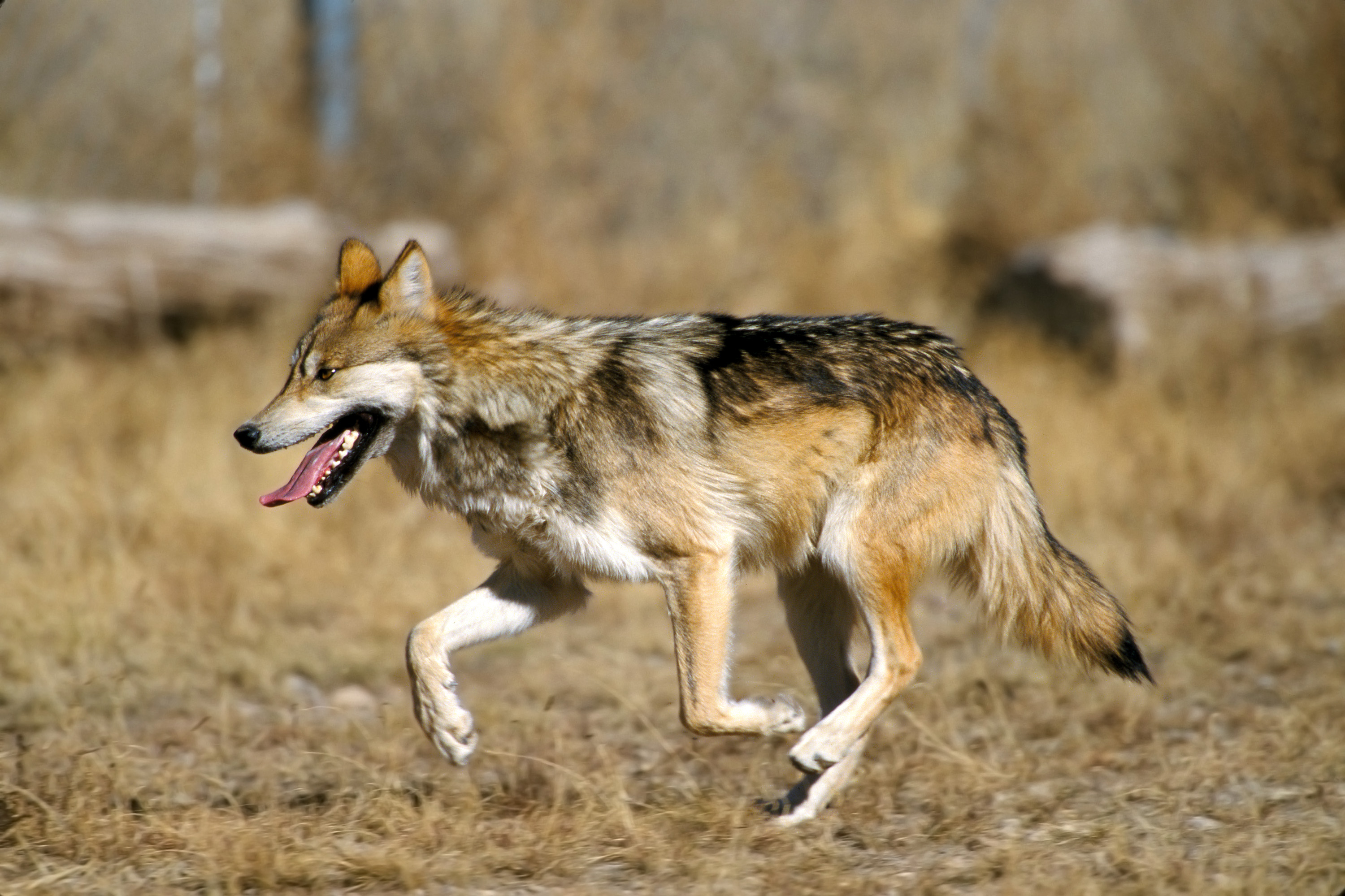


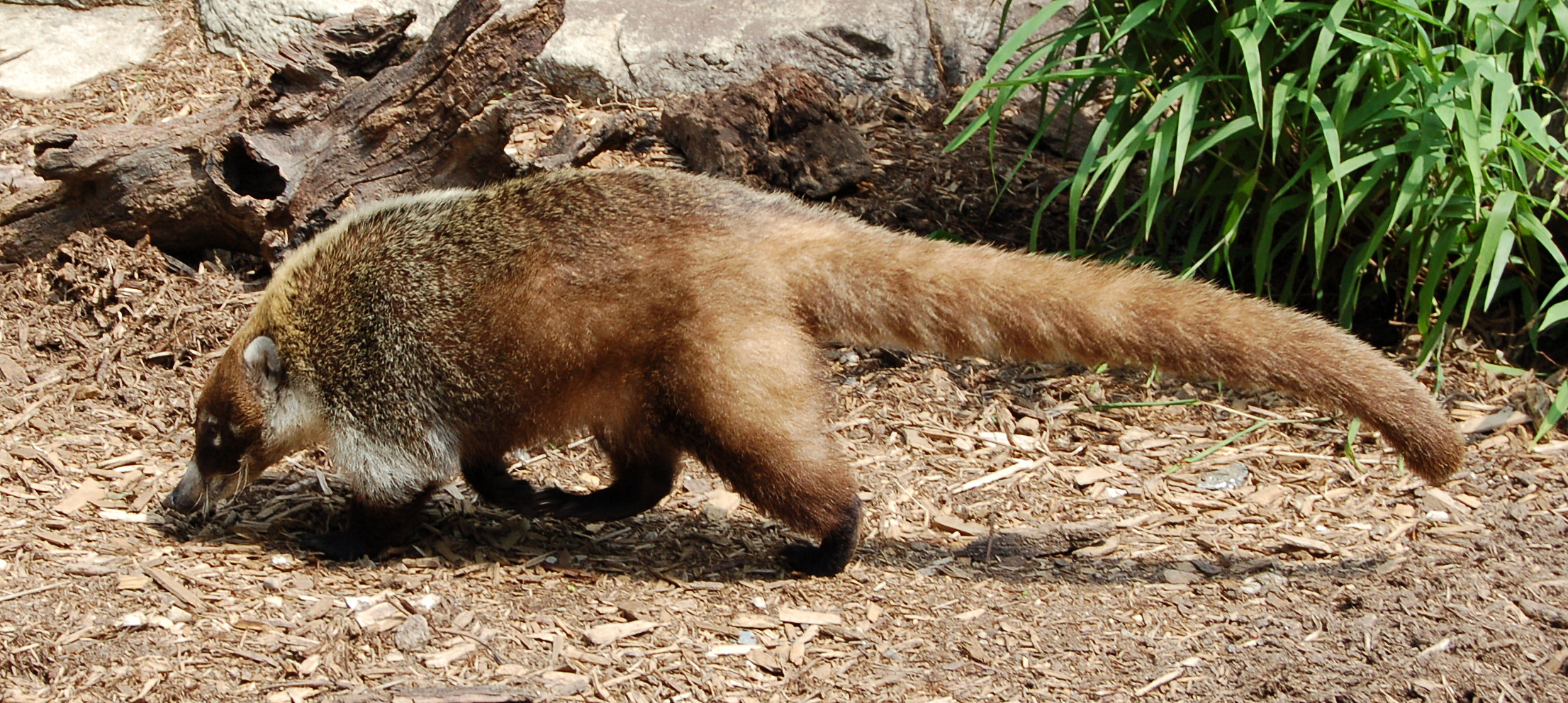
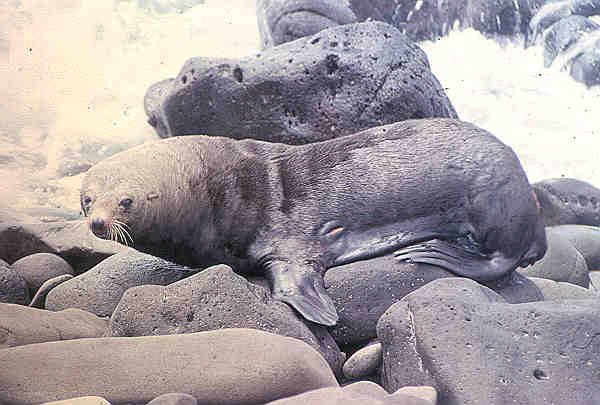

 There are over 260 species of carnivorans, the majority of which feed primarily on meat. They have a characteristic skull shape and dentition. Mexico has more native Mephitidae, mephitids than any other country, with two thirds of extant species being present. Only Costa Rica and Panama have more Procyonidae, procyonid species (one more) than Mexico (it is tied with Colombia in this respect). Large extinct carnivorans that lived in the area prior to the coming of humans include the saber-toothed cat ''Smilodon fatalis'', the scimitar cat ''Homotherium, Homotherium serum'', American lions, American cheetahs, dire wolves and Arctodus, short-faced bears.
*Suborder: Feliformia
**Family: Felidae (cats)
***Subfamily: Felinae
****Genus: ''Herpailurus''
***** Jaguarundi, ''H. yagouaroundi''
****Genus: ''Leopardus''
***** Ocelot, ''L. pardalis''
***** Margay, ''L. wiedii''
****Genus: ''Lynx''
***** Bobcat, ''L. rufus''
****Genus: ''Puma (genus), Puma''
***** Cougar, ''P. concolor''
***Subfamily: Pantherinae
****Genus: ''Panthera''
***** Jaguar, ''P. onca''
*Suborder: Caniformia
**Family: Canidae (dogs, foxes)
***Genus: ''Canis''
**** Coyote, ''C. latrans''
**** Gray wolf, ''C. lupus'' reintroduced
***** Mexican wolf, ''C. l. baileyi'' reintroduced
***Genus: ''Urocyon''
**** Gray fox, ''U. cinereoargenteus''
***Genus: ''Vulpes''
**** Kit fox, ''V. macrotis''
**Family: Ursidae (bears)
***Genus: ''Ursus (biology), Ursus''
**** American black bear, ''U. americanus''
**** Brown bear, ''U. arctos'' extirpated
***** Mexican grizzly bear, ''U. a. horribilis''
**Family: Mephitidae
***Genus: ''Conepatus''
**** American hog-nosed skunk, ''C. leuconotus''
**** Striped hog-nosed skunk, ''C. semistriatus''
***Genus: ''Mephitis (genus), Mephitis''
**** Hooded skunk, ''M. macroura''
**** Striped skunk, ''M. mephitis''
***Genus: ''Spilogale''
**** Southern spotted skunk, ''S. angustifrons''
**** Western spotted skunk, ''S. gracilis''
**** Eastern spotted skunk, ''S. putorius''
**** Pygmy spotted skunk, ''S. pygmaea''
**Family: Mustelidae (mustelids)
***Genus: ''Tayra, Eira''
**** Tayra, ''E. barbara''
***Genus: ''Sea otter, Enhydra''
**** Sea otter, ''E. lutris''
***Genus: ''Galictis''
**** Greater grison, ''G. vittata''
***Genus: ''Lontra''
**** North American river otter, ''L. canadensis'' presence uncertain
**** Neotropical river otter, ''L. longicaudis''
***Genus: ''Mustela''
**** Black-footed ferret, ''M. nigripes'' extirpated
***Genus: ''Neogale''
**** Long-tailed weasel, ''N. frenata''
***Genus: ''Taxidea''
**** American badger, ''T. taxus''
**Family: Procyonidae (raccoons)
***Genus: ''Bassariscus''
**** Ring-tailed cat, Ringtail, ''B. astutus''
**** Cacomistle, ''B. sumichrasti''
***Genus: ''Nasua''
**** White-nosed coati, ''N. narica''
***** Cozumel Island coati, ''N. n. nelsoni''
***Genus: ''Potos''
**** Kinkajou, ''P. flavus''
***Genus: ''Procyon (genus), Procyon''
**** Common raccoon, ''P. lotor''
***** Tres Marias raccoon, ''P. l. insularis''
**** Cozumel raccoon, ''P. pygmaeus''
**Clade Pinnipedia (seals, sea lions and walruses)
***Family: Otariidae (eared seals, sea lions)
****Genus: ''Arctocephalus''
***** Galápagos fur seal, ''A. galapagoensis'' vagrant
***** Guadalupe fur seal, ''A. townsendi''
****Genus: ''Callorhinus''
***** Northern fur seal, ''C. ursinus''
****Genus: ''Zalophus''
***** California sea lion, ''Z. californianus''
***Family: Phocidae (earless seals)
****Genus: ''Mirounga''
***** Northern elephant seal, ''M. angustirostris''
***** Southern elephant seal, ''M. leonina'' vagrant
****Genus: ''Neomonachus''
***** Caribbean monk seal, ''N. tropicalis''
****Genus: ''Phoca''
***** Harbor seal, ''P. vitulina''
There are over 260 species of carnivorans, the majority of which feed primarily on meat. They have a characteristic skull shape and dentition. Mexico has more native Mephitidae, mephitids than any other country, with two thirds of extant species being present. Only Costa Rica and Panama have more Procyonidae, procyonid species (one more) than Mexico (it is tied with Colombia in this respect). Large extinct carnivorans that lived in the area prior to the coming of humans include the saber-toothed cat ''Smilodon fatalis'', the scimitar cat ''Homotherium, Homotherium serum'', American lions, American cheetahs, dire wolves and Arctodus, short-faced bears.
*Suborder: Feliformia
**Family: Felidae (cats)
***Subfamily: Felinae
****Genus: ''Herpailurus''
***** Jaguarundi, ''H. yagouaroundi''
****Genus: ''Leopardus''
***** Ocelot, ''L. pardalis''
***** Margay, ''L. wiedii''
****Genus: ''Lynx''
***** Bobcat, ''L. rufus''
****Genus: ''Puma (genus), Puma''
***** Cougar, ''P. concolor''
***Subfamily: Pantherinae
****Genus: ''Panthera''
***** Jaguar, ''P. onca''
*Suborder: Caniformia
**Family: Canidae (dogs, foxes)
***Genus: ''Canis''
**** Coyote, ''C. latrans''
**** Gray wolf, ''C. lupus'' reintroduced
***** Mexican wolf, ''C. l. baileyi'' reintroduced
***Genus: ''Urocyon''
**** Gray fox, ''U. cinereoargenteus''
***Genus: ''Vulpes''
**** Kit fox, ''V. macrotis''
**Family: Ursidae (bears)
***Genus: ''Ursus (biology), Ursus''
**** American black bear, ''U. americanus''
**** Brown bear, ''U. arctos'' extirpated
***** Mexican grizzly bear, ''U. a. horribilis''
**Family: Mephitidae
***Genus: ''Conepatus''
**** American hog-nosed skunk, ''C. leuconotus''
**** Striped hog-nosed skunk, ''C. semistriatus''
***Genus: ''Mephitis (genus), Mephitis''
**** Hooded skunk, ''M. macroura''
**** Striped skunk, ''M. mephitis''
***Genus: ''Spilogale''
**** Southern spotted skunk, ''S. angustifrons''
**** Western spotted skunk, ''S. gracilis''
**** Eastern spotted skunk, ''S. putorius''
**** Pygmy spotted skunk, ''S. pygmaea''
**Family: Mustelidae (mustelids)
***Genus: ''Tayra, Eira''
**** Tayra, ''E. barbara''
***Genus: ''Sea otter, Enhydra''
**** Sea otter, ''E. lutris''
***Genus: ''Galictis''
**** Greater grison, ''G. vittata''
***Genus: ''Lontra''
**** North American river otter, ''L. canadensis'' presence uncertain
**** Neotropical river otter, ''L. longicaudis''
***Genus: ''Mustela''
**** Black-footed ferret, ''M. nigripes'' extirpated
***Genus: ''Neogale''
**** Long-tailed weasel, ''N. frenata''
***Genus: ''Taxidea''
**** American badger, ''T. taxus''
**Family: Procyonidae (raccoons)
***Genus: ''Bassariscus''
**** Ring-tailed cat, Ringtail, ''B. astutus''
**** Cacomistle, ''B. sumichrasti''
***Genus: ''Nasua''
**** White-nosed coati, ''N. narica''
***** Cozumel Island coati, ''N. n. nelsoni''
***Genus: ''Potos''
**** Kinkajou, ''P. flavus''
***Genus: ''Procyon (genus), Procyon''
**** Common raccoon, ''P. lotor''
***** Tres Marias raccoon, ''P. l. insularis''
**** Cozumel raccoon, ''P. pygmaeus''
**Clade Pinnipedia (seals, sea lions and walruses)
***Family: Otariidae (eared seals, sea lions)
****Genus: ''Arctocephalus''
***** Galápagos fur seal, ''A. galapagoensis'' vagrant
***** Guadalupe fur seal, ''A. townsendi''
****Genus: ''Callorhinus''
***** Northern fur seal, ''C. ursinus''
****Genus: ''Zalophus''
***** California sea lion, ''Z. californianus''
***Family: Phocidae (earless seals)
****Genus: ''Mirounga''
***** Northern elephant seal, ''M. angustirostris''
***** Southern elephant seal, ''M. leonina'' vagrant
****Genus: ''Neomonachus''
***** Caribbean monk seal, ''N. tropicalis''
****Genus: ''Phoca''
***** Harbor seal, ''P. vitulina''
 The odd-toed ungulates are browsing and grazing mammals. They are usually large to very large, and have relatively simple stomachs and a large middle toe. Tapirids were more widespread before humans appeared, formerly being present in temperate North America as well as the tropical regions they are found in today. Native Equidae, equids once lived in the region, having evolved in North America over Evolution of the horse, a period of 50 million years, but died out around the time of the first arrival of humans, along with at least one ungulate of South American origin, the notoungulate ''Mixotoxodon''. Sequencing of collagen from a fossil of one recently extinct notoungulate has indicated that this order was closer to the perissodactyls than any extant mammal order.
*Family: Equidae
**Genus: ''Equus (genus), Equus''
*** Wild horse, ''Equus ferus'' extirpated
**** Horse, Domestic horse, ''E. f. caballus'' introduced
*Family: Tapiridae (tapirs)
**Genus: ''Tapirus''
*** Baird's tapir, ''T. bairdii''
The odd-toed ungulates are browsing and grazing mammals. They are usually large to very large, and have relatively simple stomachs and a large middle toe. Tapirids were more widespread before humans appeared, formerly being present in temperate North America as well as the tropical regions they are found in today. Native Equidae, equids once lived in the region, having evolved in North America over Evolution of the horse, a period of 50 million years, but died out around the time of the first arrival of humans, along with at least one ungulate of South American origin, the notoungulate ''Mixotoxodon''. Sequencing of collagen from a fossil of one recently extinct notoungulate has indicated that this order was closer to the perissodactyls than any extant mammal order.
*Family: Equidae
**Genus: ''Equus (genus), Equus''
*** Wild horse, ''Equus ferus'' extirpated
**** Horse, Domestic horse, ''E. f. caballus'' introduced
*Family: Tapiridae (tapirs)
**Genus: ''Tapirus''
*** Baird's tapir, ''T. bairdii''


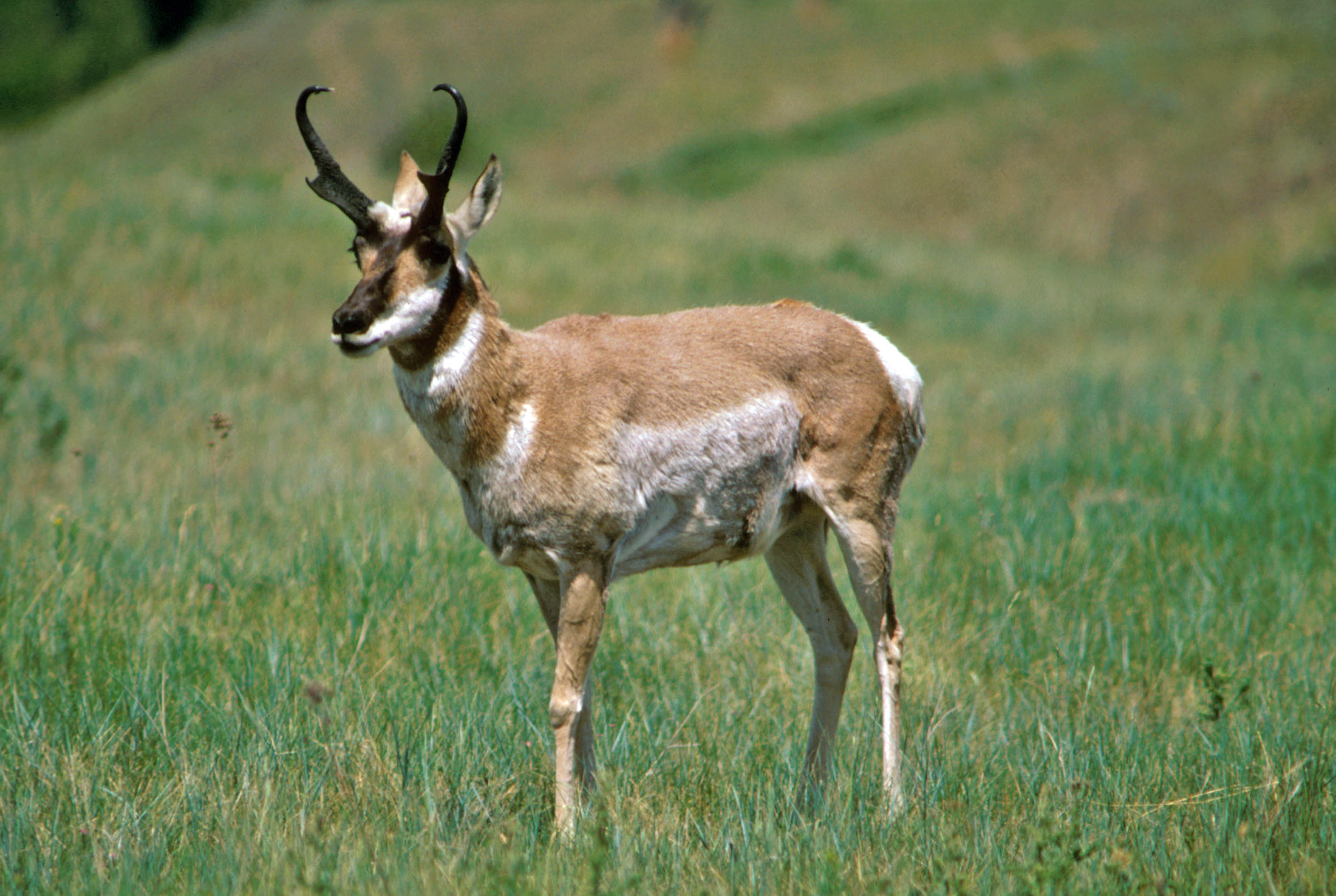

 The even-toed ungulates are ungulates whose weight is borne about equally by the third and fourth toes, rather than mostly or entirely by the third as in perissodactyls. There are about 220 noncetacean artiodactyl species, including many that are of great economic importance to humans. All of Mexico's extant ungulates are of Nearctic realm, Nearctic origin. Prior to the arrival of humans, camelids, which evolved in North America, also lived in the region, as did additional antilocaprids (e.g., ''Capromeryx minor'').
*Family: Tayassuidae (peccaries)
**Genus: ''Dicotyles''
*** Collared peccary, ''D. tajacu''
**Genus: ''Tayassu''
*** White-lipped peccary, ''T. pecari''
*Family: Cervidae (deer)
**Subfamily: Cervinae
***Genus: ''Cervus''
**** Elk, ''C. canadensis'' extirpated
***** Merriam's elk, ''C. c. merriami''
**Subfamily: Capreolinae
***Genus: ''Brocket deer, Mazama''
**** Central American red brocket, ''M. temama''
***Genus: ''Odocoileus''
**** Mule deer, ''O. hemionus''
**** Yucatan brown brocket, ''O. pandora''
**** White-tailed deer, ''O. virginianus''
*Family: Antilocapridae (pronghorn)
**Genus: ''Antilocapra''
*** Pronghorn, ''A. americana'' reintroduced
**** Mexican pronghorn, ''A. a. mexicana''
**** Baja California pronghorn, ''A. a. peninsularis''
**** Sonoran pronghorn, ''A. a. sonoriensis''
*Family: Bovidae (cattle, antelope, sheep, goats)
**Subfamily: Bovinae
***Genus: ''Bison''
**** American bison, ''B. bison'' reintroduced
*****Plains bison, ''B. b. bison'' reintroduced
***Genus: ''Boselaphus''
****Nilgai, ''B. tragocamelus'' introduced
**Subfamily: Caprinae
***Genus: ''Ovis''
**** Bighorn sheep, ''O. canadensis''
***** Desert bighorn sheep, ''O. c. nelsoni''
The even-toed ungulates are ungulates whose weight is borne about equally by the third and fourth toes, rather than mostly or entirely by the third as in perissodactyls. There are about 220 noncetacean artiodactyl species, including many that are of great economic importance to humans. All of Mexico's extant ungulates are of Nearctic realm, Nearctic origin. Prior to the arrival of humans, camelids, which evolved in North America, also lived in the region, as did additional antilocaprids (e.g., ''Capromeryx minor'').
*Family: Tayassuidae (peccaries)
**Genus: ''Dicotyles''
*** Collared peccary, ''D. tajacu''
**Genus: ''Tayassu''
*** White-lipped peccary, ''T. pecari''
*Family: Cervidae (deer)
**Subfamily: Cervinae
***Genus: ''Cervus''
**** Elk, ''C. canadensis'' extirpated
***** Merriam's elk, ''C. c. merriami''
**Subfamily: Capreolinae
***Genus: ''Brocket deer, Mazama''
**** Central American red brocket, ''M. temama''
***Genus: ''Odocoileus''
**** Mule deer, ''O. hemionus''
**** Yucatan brown brocket, ''O. pandora''
**** White-tailed deer, ''O. virginianus''
*Family: Antilocapridae (pronghorn)
**Genus: ''Antilocapra''
*** Pronghorn, ''A. americana'' reintroduced
**** Mexican pronghorn, ''A. a. mexicana''
**** Baja California pronghorn, ''A. a. peninsularis''
**** Sonoran pronghorn, ''A. a. sonoriensis''
*Family: Bovidae (cattle, antelope, sheep, goats)
**Subfamily: Bovinae
***Genus: ''Bison''
**** American bison, ''B. bison'' reintroduced
*****Plains bison, ''B. b. bison'' reintroduced
***Genus: ''Boselaphus''
****Nilgai, ''B. tragocamelus'' introduced
**Subfamily: Caprinae
***Genus: ''Ovis''
**** Bighorn sheep, ''O. canadensis''
***** Desert bighorn sheep, ''O. c. nelsoni''

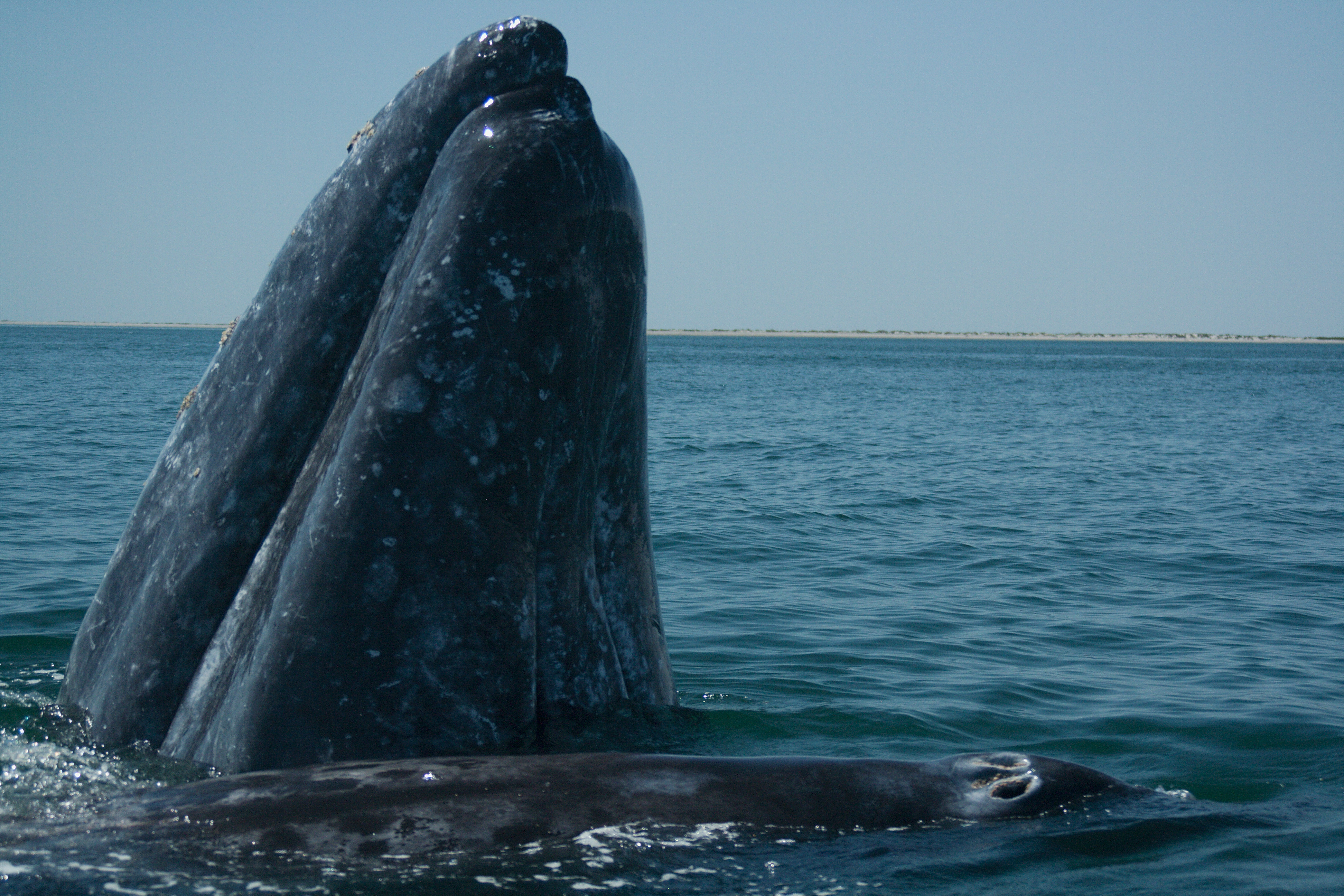




 The order Cetacea includes whales, dolphins and porpoises. They are the mammals most fully aquatic adaptation, adapted to aquatic life with a spindle-shaped nearly hairless body, protected by a thick layer of blubber, and forelimbs and tail modified to provide propulsion underwater. Their closest extant relatives are the Hippopotamidae, hippos, which are artiodactyls, from which cetaceans descended; cetaceans are thus also artiodactyls. Lagoons on the coast of Baja California Sur provide calving grounds for the eastern Pacific population of gray whales. The
The order Cetacea includes whales, dolphins and porpoises. They are the mammals most fully aquatic adaptation, adapted to aquatic life with a spindle-shaped nearly hairless body, protected by a thick layer of blubber, and forelimbs and tail modified to provide propulsion underwater. Their closest extant relatives are the Hippopotamidae, hippos, which are artiodactyls, from which cetaceans descended; cetaceans are thus also artiodactyls. Lagoons on the coast of Baja California Sur provide calving grounds for the eastern Pacific population of gray whales. The
Mexico
Mexico, officially the United Mexican States, is a country in North America. It is the northernmost country in Latin America, and borders the United States to the north, and Guatemala and Belize to the southeast; while having maritime boundar ...
. As of September 2014, there were 536 mammalian species or subspecies listed. Based on IUCN
The International Union for Conservation of Nature (IUCN) is an international organization working in the field of nature conservation and sustainable use of natural resources. Founded in 1948, IUCN has become the global authority on the status ...
data, Mexico has 23% more noncetacean mammal species than the U.S. and Canada combined in an area only 10% as large, or a species density over 12 times that of its northern neighbors. Mexico's high mammal biodiversity is in part a reflection of the wide array of biome
A biome () is a distinct geographical region with specific climate, vegetation, and animal life. It consists of a biological community that has formed in response to its physical environment and regional climate. In 1935, Tansley added the ...
s present over its latitudinal, climatic and altitudinal ranges, from lowland tropical rainforest
Tropical rainforests are dense and warm rainforests with high rainfall typically found between 10° north and south of the Equator. They are a subset of the tropical forest biome that occurs roughly within the 28° latitudes (in the torrid zo ...
to temperate desert
A desert is a landscape where little precipitation occurs and, consequently, living conditions create unique biomes and ecosystems. The lack of vegetation exposes the unprotected surface of the ground to denudation. About one-third of the la ...
to montane forest
Montane ecosystems are found on the slopes of mountains. The alpine climate in these regions strongly affects the ecosystem because temperatures lapse rate, fall as elevation increases, causing the ecosystem to stratify. This stratification is ...
to alpine tundra
Alpine tundra is a type of natural region or biome that does not contain trees because it is at high elevation, with an associated harsh climate. As the latitude of a location approaches the poles, the threshold elevation for alpine tundra gets ...
. The general increase in terrestrial biodiversity moving towards the equator is another important factor in the comparison. Mexico includes much of the Mesoamerica
Mesoamerica is a historical region and cultural area that begins in the southern part of North America and extends to the Pacific coast of Central America, thus comprising the lands of central and southern Mexico, all of Belize, Guatemala, El S ...
n and Madrean pine-oak woodlands biodiversity hotspot
A biodiversity hotspot is a ecoregion, biogeographic region with significant levels of biodiversity that is threatened by human habitation. Norman Myers wrote about the concept in two articles in ''The Environmentalist'' in 1988 and 1990, after ...
s. From a biogeographic
Biogeography is the study of the distribution of species and ecosystems in geographic space and through geological time. Organisms and biological communities often vary in a regular fashion along geographic gradients of latitude, elevation, ...
standpoint, most of Mexico is linked to the rest of North America as part of the Nearctic realm
The Nearctic realm is one of the eight biogeographic realms constituting the Earth's land surface.
The Nearctic realm covers most of North America, including Greenland, Central Florida, and the highlands of Mexico. The parts of North America t ...
. However, the lowlands of southern Mexico are linked with Central America
Central America is a subregion of North America. Its political boundaries are defined as bordering Mexico to the north, Colombia to the southeast, the Caribbean to the east, and the Pacific Ocean to the southwest. Central America is usually ...
and South America as part of the Neotropical realm
The Neotropical realm is one of the eight biogeographic realms constituting Earth's land surface. Physically, it includes the tropics, tropical Ecoregion#Terrestrial, terrestrial ecoregions of the Americas and the entire South American temperat ...
. Extensive mixing of Nearctic and Neotropical mammal species commenced only three million years ago, when the formation of the Isthmus of Panama
The Isthmus of Panama, historically known as the Isthmus of Darien, is the narrow strip of land that lies between the Caribbean Sea and the Pacific Ocean, linking North America, North and South America. The country of Panama is located on the i ...
ended South America's long period of isolation and precipitated the Great American Interchange
The Great American Biotic Interchange (commonly abbreviated as GABI), also known as the Great American Interchange and the Great American Faunal Interchange, was an important late Cenozoic paleozoogeographic biotic interchange event in which land ...
. Twenty of Mexico's extant nonflying species (opossums
Opossums () are members of the marsupial order Didelphimorphia () endemic to the Americas. The largest order of marsupials in the Western Hemisphere, it comprises 126 species in 18 genera. Opossums originated in South America and entered North A ...
, armadillos
Armadillos () are New World placental mammals in the order Cingulata. They form part of the superorder Xenarthra, along with the anteaters and sloths. 21 extant species of armadillo have been described, some of which are distinguished by th ...
, anteaters
Anteaters are the four extant mammal species in the suborder Vermilingua (meaning "worm tongue"), commonly known for eating ants and termites. The individual species have other names in English and other languages. Together with sloths, they ar ...
, monkeys
Monkey is a common name that may refer to most mammals of the infraorder Simiiformes, also known as simians. Traditionally, all animals in the group now known as simians are counted as monkeys except the apes. Thus monkeys, in that sense, co ...
and caviomorph rodents) are of South American origin. Most of the megafauna
In zoology, megafauna (from Ancient Greek, Greek μέγας ''megas'' "large" and Neo-Latin ''fauna'' "animal life") are large animals. The precise definition of the term varies widely, though a common threshold is approximately , this lower en ...
that formerly inhabited the region became extinct at the end of the Pleistocene
The Pleistocene ( ; referred to colloquially as the ''ice age, Ice Age'') is the geological epoch (geology), epoch that lasted from to 11,700 years ago, spanning the Earth's most recent period of repeated glaciations. Before a change was fin ...
about 10,000 years ago, shortly after the arrival of the first humans. Increasing alteration and destruction of natural habitats by expanding human populations during the last several centuries is causing further attrition of the region's biodiversity, as exemplified by the " hotspot" designations (by definition, such areas have lost over 70% of their primary vegetation).
The following tags are used to highlight each species' conservation status as assessed by the International Union for Conservation of Nature
The International Union for Conservation of Nature (IUCN) is an international organization working in the field of nature conservation and sustainable use of natural resources. Founded in 1948, IUCN has become the global authority on the stat ...
; those on the left are used here, those in the second column in some other articles:
Of the listed taxa, 7 are extinct, 1 (not recognized by the IUCN) is possibly extinct, 30 are critically endangered, 46 are endangered, 26 are vulnerable, and 23 are near threatened. These status tags were most recently updated in April 2011. Six of the extinct or possibly extinct taxa and 11 of the critically endangered taxa are insular (all but two of these are rodents); another 13 of the critically endangered species (all rodents or shrews) are montane
Montane ecosystems are found on the slopes of mountains. The alpine climate in these regions strongly affects the ecosystem because temperatures lapse rate, fall as elevation increases, causing the ecosystem to stratify. This stratification is ...
. The only critically endangered species that are neither rodents nor shrews are the Cozumel Island raccoon and the vaquita
The vaquita ( ; ''Phocoena sinus'') is a species of porpoise endemic to the northern end of the Gulf of California in Baja California, Mexico. Reaching a maximum body length of (females) or (males), it is the smallest of all living cetaceans. ...
. The vaquita population estimate has dropped below 100 as of 2014 and it is regarded as being in imminent danger of extinction.
Subclass:
Theria
Theria ( or ; ) is a scientific classification, subclass of mammals amongst the Theriiformes. Theria includes the eutherians (including the Placentalia, placental mammals) and the metatherians (including the marsupials) but excludes the egg-lay ...
Infraclass:
Metatheria
Metatheria is a mammalian clade that includes all mammals more closely related to marsupials than to placentals. First proposed by Thomas Henry Huxley in 1880, it is a more inclusive group than the marsupials; it contains all marsupials as wel ...

Order:
Didelphimorphia
Opossums () are members of the marsupial order Didelphimorphia () endemic to the Americas. The largest order of marsupials in the Western Hemisphere, it comprises 126 species in 18 genera. Opossums originated in South America and entered North A ...
(common opossums)
Didelphimorphia is the order of common opossums of the Western Hemisphere
The Western Hemisphere is the half of the planet Earth that lies west of the Prime Meridian (which crosses Greenwich, London, United Kingdom) and east of the 180th meridian.- The other half is called the Eastern Hemisphere. Geopolitically, ...
. Opossums probably diverged from the basic South American marsupial
Marsupials are a diverse group of mammals belonging to the infraclass Marsupialia. They are natively found in Australasia, Wallacea, and the Americas. One of marsupials' unique features is their reproductive strategy: the young are born in a r ...
s in the late Cretaceous
The Cretaceous ( ) is a geological period that lasted from about 143.1 to 66 mya (unit), million years ago (Mya). It is the third and final period of the Mesozoic Era (geology), Era, as well as the longest. At around 77.1 million years, it is the ...
or early Paleocene
The Paleocene ( ), or Palaeocene, is a geological epoch (geology), epoch that lasted from about 66 to 56 mya (unit), million years ago (mya). It is the first epoch of the Paleogene Period (geology), Period in the modern Cenozoic Era (geology), ...
. They are small to medium-sized marsupials, about the size of a large house cat
The cat (''Felis catus''), also referred to as the domestic cat or house cat, is a small domesticated carnivorous mammal. It is the only domesticated species of the family Felidae. Advances in archaeology and genetics have shown that the ...
, with a long snout and prehensile
Prehensility is the quality of an appendage or organ that has adapted for grasping or holding. The word is derived from the Latin term ''prehendere'', meaning "to grasp". The ability to grasp is likely derived from a number of different origin ...
tail.
*Family: Didelphidae (American opossums)
**Subfamily: Caluromyinae
Caluromyinae is a subfamily of opossums. It includes the extant genera '' Caluromys'' and '' Caluromysiops'', as well as the extinct
Extinction is the termination of an organism by the death of its Endling, last member. A taxon may become ...
***Genus: '' Caluromys''
**** Derby's woolly opossum
Derby's woolly opossum (''Caluromys derbianus''), or the Central American woolly opossum, is an opossum found in deciduous and moist evergreen forests of Central America, from southern Mexico to western Ecuador and Colombia. It was first describ ...
, ''C. derbianus''
**Subfamily: Didelphinae
The Didelphinae are a subfamily of opossums consisting of 15 genera and 123 species. Specimens have been collected throughout the Americas, but are predominant in South and Central America.
Some sources call this subfamily the "American opossums ...
***Genus: ''Chironectes
The water opossum (''Chironectes minimus''), also locally known as the yapok (), is a marsupial of the family Didelphidae.* It is the only monotypic species of its genus, ''Chironectes''. This semiaquatic creature is found in and near freshwat ...
''
**** Water opossum
The water opossum (''Chironectes minimus''), also locally known as the yapok (), is a marsupial of the family Didelphidae.* It is the only monotypic species of its genus, ''Chironectes''. This semiaquatic creature is found in and near freshwat ...
, ''C. minimus''
***Genus: ''Didelphis
''Didelphis'' is a genus of New World marsupials. The six species in the genus ''Didelphis'', commonly known as Large American opossums, are members of the ''opossum'' order (biology), order, Didelphimorphia.
The genus ''Didelphis'' is composed ...
''
**** Common opossum
The common opossum (''Didelphis marsupialis''), also called the southern or black-eared opossum or gambá, and sometimes called a possum, is a marsupial species living from the northeast of Mexico to Bolivia (reaching the coast of the South Paci ...
, ''D. marsupialis''
**** Virginia opossum
The Virginia opossum (''Didelphis virginiana''), also known as the North American opossum, is a member of the opossum family found from southern Canada to northern Costa Rica, making it the northernmost marsupial in the world and the only marsup ...
, ''D. virginiana''
***Genus: ''Marmosa
The 27 species in the genus ''Marmosa'' are relatively small Neotropical members of the family Didelphidae. This genus is one of three that are known as mouse opossums. The others are '' Thylamys'' (the "fat-tailed mouse opossums") and '' Tlacu ...
''
**** Mexican mouse opossum
The Mexican mouse opossum (''Marmosa mexicana'') is a species of North American opossum in the family Didelphidae.
Description
''Marmosa mexicana'' is a small to moderate-sized reddish-brown marsupial, varying from bright to dull coloration. Hai ...
, ''M. mexicana''
***Genus: '' Metachirus''
**** Brown four-eyed opossum, ''M. nudicaudatus''
***Genus: '' Philander''
**** Gray four-eyed opossum, ''P. opossum''
***Genus: '' Tlacuatzin''
**** Grayish mouse opossum, ''T. canescens''
Infraclass:
Eutheria
Eutheria (from Greek , 'good, right' and , 'beast'; ), also called Pan-Placentalia, is the clade consisting of Placentalia, placental mammals and all therian mammals that are more closely related to placentals than to marsupials.
Eutherians ...
Order:
Sirenia
The Sirenia (), commonly referred to as sea cows or sirenians, are an order of fully aquatic, herbivorous mammals that inhabit swamps, rivers, estuaries, marine wetlands, and coastal marine waters. The extant Sirenia comprise two distinct famili ...
(manatees and dugongs)
 Sirenia is an order of fully aquatic, herbivorous mammals that inhabit rivers, estuaries, coastal marine waters, swamps, and marine wetlands. All four species are endangered. They evolved about 50 million years ago, and their closest living relatives are
Sirenia is an order of fully aquatic, herbivorous mammals that inhabit rivers, estuaries, coastal marine waters, swamps, and marine wetlands. All four species are endangered. They evolved about 50 million years ago, and their closest living relatives are elephant
Elephants are the largest living land animals. Three living species are currently recognised: the African bush elephant ('' Loxodonta africana''), the African forest elephant (''L. cyclotis''), and the Asian elephant ('' Elephas maximus ...
s. Manatees are the only extant afrotheria
Afrotheria ( from Latin ''Afro-'' "of Africa" + ''theria'' "wild beast") is a superorder of placental mammals, the living members of which belong to groups that are either currently living in Africa or of African origin: golden moles, elephan ...
ns in the Americas. However, a number proboscid species, some of which survived until the arrival of Paleo-Indians
Paleo-Indians were the first peoples who entered and subsequently inhabited the Americas towards the end of the Late Pleistocene period. The prefix ''paleo-'' comes from . The term ''Paleo-Indians'' applies specifically to the lithic period in ...
, once inhabited the region. Mammoths
A mammoth is any species of the extinct elephantid genus ''Mammuthus.'' They lived from the late Miocene epoch (from around 6.2 million years ago) into the Holocene until about 4,000 years ago, with mammoth species at various times inhabi ...
, mastodons
A mastodon, from Ancient Greek μαστός (''mastós''), meaning "breast", and ὀδούς (''odoús'') "tooth", is a member of the genus ''Mammut'' (German for 'mammoth'), which was endemic to North America and lived from the late Miocene to ...
and gomphothere
Gomphotheres are an extinct group of proboscideans related to modern elephants. First appearing in Africa during the Oligocene, they dispersed into Eurasia and North America during the Miocene and arrived in South America during the Pleistocene a ...
s all formerly lived in Mexico.
*Family: Trichechidae
Trichechidae is a family of sirenians that includes all living manatees and several extinct genera.
Systematics
Trichechidae
*MiosireninaeM. Voss. 2014. On the invalidity of Halitherium schinzii Kaup, 1838 (Mammalia, Sirenia), with comments on ...
**Genus: ''Trichechus
Manatees (, family Trichechidae, genus ''Trichechus'') are large, fully aquatic, mostly herbivorous marine mammals sometimes known as sea cows. There are three accepted living species of Trichechidae, representing three of the four living spec ...
''
*** West Indian manatee
The West Indian manatee (''Trichechus manatus''), also known as the North American manatee, is a large, aquatic mammal native to warm coastal areas of the Caribbean, from the Eastern United States to northern Brazil. Living alone or in herds, it ...
, ''T. manatus''
Order:
Cingulata
Cingulata, part of the superorder Xenarthra, is an order of armored New World placental mammals. The armadillos, whose species are split between the families Dasypodidae and Chlamyphoridae, are the only surviving members of the order. Two grou ...
(armadillos)
 Armadillos are small mammals with a bony armored shell. Two of twenty-one extant species are present in Mexico; the remainder are only found in South America, where they originated. Their much larger relatives, the
Armadillos are small mammals with a bony armored shell. Two of twenty-one extant species are present in Mexico; the remainder are only found in South America, where they originated. Their much larger relatives, the pampatheres
Pampatheriidae ("Pampas beasts") is an extinct family of large cingulates related to armadillos. They first appeared in South America during the mid-Miocene, and '' Holmesina'' and '' Pampatherium'' spread to North America during the Pleistocen ...
and glyptodonts, once lived in North and South America but went extinct following the appearance of humans.
*Family: Dasypodidae
Dasypodidae, from Ancient Greek δασύς (''dasús''), meaning "hair", and πούς (''poús''), meaning "foot", is a family of mostly extinct genera of armadillos. One genus, ''Dasypus'', is extant, with at least seven living species.
__TO ...
(long-nosed armadillos)
**Subfamily: Dasypodinae
Dasypodidae, from Ancient Greek δασύς (''dasús''), meaning "hair", and πούς (''poús''), meaning "foot", is a family of mostly extinct genera of armadillos. One genus, ''Dasypus'', is extant, with at least seven living species.
__TO ...
***Genus: ''Dasypus
''Dasypus'' is the only extant genus in the family Dasypodidae. Its species are known as long-nosed or naked-tailed armadillos. They are found in South America, South, Central America, Central, and North America, as well as on the Caribbean islan ...
''
**** Nine-banded armadillo
The nine-banded armadillo (''Dasypus novemcinctus''), also called the nine-banded long-nosed armadillo or common long-nosed armadillo, is a species of armadillo native to North America, North, Central America, Central, and South America, making ...
, ''D. novemcinctus''
*Family: Chlamyphoridae
Chlamyphoridae is a family of cingulate mammals. While glyptodonts have traditionally been considered stem-group cingulates outside the group that contains modern armadillos, there had been speculation that the extant family Dasypodidae could ...
(armadillos)
**Subfamily: Tolypeutinae
Tolypeutinae is a subfamily of armadillos in the family Chlamyphoridae, consisting of the giant, three-banded and naked-tailed armadillos.
__TOC__
Taxonomy
It contains the following genera:
*'' Cabassous''
*'' Kuntinaru''
*'' Priodontes''
*' ...
***Genus: ''Cabassous
''Cabassous'' is a genus of South and Central American armadillos. The name is the Latinised form of the Carib language, Kalini word for "armadillo".
Cladogram of living ''Cabassous''
The genus contains the following four species:
Reference ...
''
**** Northern naked-tailed armadillo, ''C. centralis''
Order:
Pilosa
The Order (biology), order Pilosa is a clade of xenarthran placental mammals, native to the Americas. It includes anteaters and sloths (which include the extinct ground sloths). The name comes from the Latin word for "hairy".
Origins and taxon ...
(anteaters, sloths and tamanduas)

 The order Pilosa is extant only in the Americas and includes the
The order Pilosa is extant only in the Americas and includes the anteater
Anteaters are the four extant mammal species in the suborder Vermilingua (meaning "worm tongue"), commonly known for eating ants and termites. The individual species have other names in English and other languages. Together with sloths, they ar ...
s, sloth
Sloths are a Neotropical realm, Neotropical group of xenarthran mammals constituting the suborder Folivora, including the extant Arboreal locomotion, arboreal tree sloths and extinct terrestrial ground sloths. Noted for their slowness of move ...
s, and tamandua
''Tamandua'' is a genus of anteaters in the Myrmecophagidae family with two species: the southern tamandua (''T. tetradactyla'') and the northern tamandua (''T. mexicana''). They live in forests and grasslands, are semiarboreal, and possess part ...
s. Their ancestral home is South America. Numerous ground sloth
Ground sloths are a diverse group of extinct sloths in the mammalian superorder Xenarthra. They varied widely in size with the largest, belonging to genera '' Lestodon'', ''Eremotherium'' and ''Megatherium'', being around the size of elephants. ...
s, some of which reached the size of elephants, were once present in both North and South America, as well as on the Antilles, but all went extinct following the arrival of humans.
*Suborder: Vermilingua
Anteaters are the four extant mammal species in the suborder Vermilingua (meaning "worm tongue"), commonly known for eating ants and termites. The individual species have other names in English and other languages. Together with sloths, they ar ...
**Family: Cyclopedidae
The Cyclopedidae is a family of anteaters that includes the silky anteater
The silky anteater, also known as the pygmy anteater, has traditionally been considered a single species of anteater, ''Cyclopes didactylus'', in the genus ''Cyclopes ...
***Genus: ''Cyclopes
In Greek mythology and later Roman mythology, the Cyclopes ( ; , ''Kýklōpes'', "Circle-eyes" or "Round-eyes"; singular Cyclops ; , ''Kýklōps'') are giant one-eyed creatures. Three groups of Cyclopes can be distinguished. In Hesiod's ''The ...
''
**** Common silky anteater, ''C. didactylus''
**** Central American silky anteater, ''C. dorsalis''
**Family: Myrmecophagidae
The Myrmecophagidae are a family of anteaters. Two genera and three species are in the family, consisting of the giant anteater, and the tamanduas. The fossil '' Eurotamandua'' from the Messel Pit in Germany may be an early anteater, but its sta ...
(American anteaters)
***Genus: ''Tamandua
''Tamandua'' is a genus of anteaters in the Myrmecophagidae family with two species: the southern tamandua (''T. tetradactyla'') and the northern tamandua (''T. mexicana''). They live in forests and grasslands, are semiarboreal, and possess part ...
''
**** Northern tamandua
The northern tamandua (''Tamandua mexicana'') is a species of tamandua, an anteater in the family Myrmecophagidae. They live in tropical and subtropical forests from southern Mexico, through Central America, and to the edge of the northern Andes. ...
, ''T. mexicana''
Order:
Primates
Primates is an order of mammals, which is further divided into the strepsirrhines, which include lemurs, galagos, and lorisids; and the haplorhines, which include tarsiers and simians ( monkeys and apes). Primates arose 74–63 ...
The order Primates includes the lemur
Lemurs ( ; from Latin ) are Strepsirrhini, wet-nosed primates of the Superfamily (biology), superfamily Lemuroidea ( ), divided into 8 Family (biology), families and consisting of 15 genera and around 100 existing species. They are Endemism, ...
s, monkey
Monkey is a common name that may refer to most mammals of the infraorder Simiiformes, also known as simians. Traditionally, all animals in the group now known as simians are counted as monkeys except the apes. Thus monkeys, in that sense, co ...
s, and ape
Apes (collectively Hominoidea ) are a superfamily of Old World simians native to sub-Saharan Africa and Southeast Asia (though they were more widespread in Africa, most of Asia, and Europe in prehistory, and counting humans are found global ...
s, with the latter category including humans
Humans (''Homo sapiens'') or modern humans are the most common and widespread species of primate, and the last surviving species of the genus ''Homo''. They are Hominidae, great apes characterized by their Prehistory of nakedness and clothing ...
. It is divided into four main groupings: strepsirrhine
Strepsirrhini or Strepsirhini (; ) is a suborder of primates that includes the lemuriform primates, which consist of the lemurs of Madagascar, galagos ("bushbabies") and pottos from Africa, and the lorises from India and Southeast Asia. Colle ...
s, tarsier
Tarsiers ( ) are haplorhine primates of the family Tarsiidae, which is the lone extant family within the infraorder Tarsiiformes. Although the group was prehistorically more globally widespread, all of the existing species are restricted to M ...
s, monkeys of the New World (parvorder
Order () is one of the eight major hierarchical taxonomic ranks in Linnaean taxonomy. It is classified between family and class. In biological classification, the order is a taxonomic rank used in the classification of organisms and recognized ...
Platyrrhini), and monkeys and apes of the Old World. Mexico's 2 genera of nonhuman primates compares to 6 in Central America, 20 in South America, 15 in Madagascar, 23 in Africa and 19 in Asia. Mexican and Central American monkeys are recent immigrants from South America, where their ancestors arrived after rafting over from Africa roughly 25 million years ago. Southeastern Mexico is the northernmost limit of the distribution of New World monkeys, which are restricted to tropical rainforest
Tropical rainforests are dense and warm rainforests with high rainfall typically found between 10° north and south of the Equator. They are a subset of the tropical forest biome that occurs roughly within the 28° latitudes (in the torrid zo ...
habitat.
*Suborder: Haplorrhini
Haplorhini (), the haplorhines (Greek for "simple-nosed") or the "dry-nosed" primates is a suborder of primates containing the tarsiers and the simians (Simiiformes or anthropoids), as sister of the Strepsirrhini ("moist-nosed"). The name is som ...
**Infraorder: Simiiformes
The simians, anthropoids, or higher primates are an infraorder (Simiiformes ) of primates containing all animals traditionally called monkeys and apes. More precisely, they consist of the parvorders Platyrrhini (New World monkeys) and Ca ...
***Parvorder: Platyrrhini
****Family: Atelidae
The Atelidae are one of the five families of New World monkeys now recognised. It was formerly included in the family Cebidae. Atelids are generally larger monkeys; the family includes the howler, spider, woolly, and woolly spider monkeys (t ...
*****Subfamily: Alouattinae
Howler monkeys (genus ''Alouatta'', monotypic in subfamily Alouattinae) are the most widespread primate genus in the Neotropics and are among the largest of the platyrrhines along with the muriquis (''Brachyteles''), the spider monkeys (''Ateles ...
******Genus: ''Alouatta
Howler monkeys (genus ''Alouatta'', monotypic in subfamily Alouattinae) are the most widespread primate genus in the Neotropics and are among the largest of the platyrrhines along with the muriquis (''Brachyteles''), the spider monkeys (''Atele ...
''
******* Mantled howler
The mantled howler (''Alouatta palliata'') is a species of howler monkey, a type of New World monkey, from Central America, Central and South America. It is one of the monkey species most often seen and heard in the wild in Central America. It ta ...
, ''A. palliata''
******* Guatemalan black howler, ''A. pigra''
*****Subfamily: Atelinae
The Atelinae are a subfamily of New World monkeys in the family Atelidae, and includes the various spider monkey, spider and woolly monkeys. The primary distinguishing feature of the atelines is their long prehensile tails, which can support thei ...
******Genus: ''Ateles
Spider monkeys are New World monkeys belonging to the genus ''Ateles'', part of the subfamily Atelinae, family Atelidae. Like other atelines, they are found in tropical forests of Central and South America, from southern Mexico to Brazil. The g ...
''
******* Geoffroy's spider monkey
Geoffroy's spider monkey (''Ateles geoffroyi''), also known as the black-handed spider monkey or the Central American spider monkey, is a species of spider monkey, a type of New World monkey, from Central America, parts of Mexico and possibly a ...
, ''A. geoffroyi''
Order:
Rodent
Rodents (from Latin , 'to gnaw') are mammals of the Order (biology), order Rodentia ( ), which are characterized by a single pair of continuously growing incisors in each of the upper and Mandible, lower jaws. About 40% of all mammal specie ...
ia (rodents)



















 Rodents make up the largest order of mammals, with over 40% of mammalian species. They have two
Rodents make up the largest order of mammals, with over 40% of mammalian species. They have two incisor
Incisors (from Latin ''incidere'', "to cut") are the front teeth present in most mammals. They are located in the premaxilla above and on the mandible below. Humans have a total of eight (two on each side, top and bottom). Opossums have 18, wher ...
s in the upper and lower jaw which grow continually and must be kept short by gnawing. Most rodents are small, although the capybara
The capybara or greater capybara (''Hydrochoerus hydrochaeris'') is the largest living rodent, native to South America. It is a member of the genus '' Hydrochoerus''. The only other extant member is the lesser capybara (''Hydrochoerus isthmi ...
can weigh up to . According to the IUCN listing, Mexico has more rodent species (236 as of April 2011) than any other country in the world (Brazil is second with 222). Of Mexico's rodents, 2% are caviomorphs, 14.5% are sciurids, 25.5% are castorimorphs and 58% are cricetids. This distribution is fairly similar to that of the remainder of North America (although sciurids are relatively twice as abundant to the north, at the expense of cricetids), but is very different from that of South America, where the corresponding figures are 36%, 3%, 1% and 60%. Of Mexico's cricetids, 17% are sigmodontine, while the figure for South America is 99.5%. Mexico's caviomorphs are recent immigrants from South America, where their ancestors washed ashore after rafting across the Atlantic
The Atlantic Ocean is the second largest of the world's five oceanic divisions, with an area of about . It covers approximately 17% of Earth's surface and about 24% of its water surface area. During the Age of Discovery, it was known for se ...
from Africa about 40–45 million years ago. Conversely, South America's sciurids, castorimorphs and cricetids are recent immigrants from Central America (with sigmodontines getting a head start on the others).
*Suborder: Hystricomorpha
Hystricomorpha (from Greek ὕστριξ, ''hystrix'' 'porcupine' and Greek μορφή, ''morphē'' 'form') is a term referring to families and orders of rodents which has had many definitions throughout its history. In the broadest sense, it ref ...
**Family: Erethizontidae (New World porcupines)
***Subfamily: Erethizontinae
****Genus: '' Erethizon''
***** North American porcupine
The North American porcupine (''Erethizon dorsatum''), also known as the Canadian porcupine, is a large quill-covered rodent in the New World porcupine family. It is the second largest rodent in North America after the North American beaver (''Ca ...
, ''E. dorsatum''
****Genus: '' Coendou''
***** Mexican hairy dwarf porcupine
The Mexican hairy dwarf porcupine or Mexican Hairy Dwarf Porcupine (''Coendou mexicanus'') is a species of rodent in the family Erethizontidae. It is found in Costa Rica, El Salvador, Guatemala, Honduras, Panama, Mexico, Nicaragua and Belize.Bio ...
, ''Coendou mexicanus''
**Family: Dasyproctidae
Dasyproctidae is a family of large South American rodents, comprising the agoutis and acouchis. Their fur is a reddish or dark colour above, with a paler underside. They are herbivore, herbivorous, often feeding on ripe fruit that falls from tree ...
(agoutis and pacas)
***Genus: '' Dasyprocta''
**** Mexican agouti
The Mexican agouti, (''Dasyprocta mexicana)'', also known as the Mexican black agouti, is a species of rodent in the genus '' Dasyprocta''. This species was first discovered in 1860 in Veracruz, Mexico and described by Henri Louis Frédéric de S ...
, ''Dasyprocta mexicana''
**** Central American agouti
The Central American agouti (''Dasyprocta punctata'') is a species of agouti from the family Dasyproctidae. The main portion of its range is from Chiapas and the Yucatan Peninsula (southern Mexico), through Central America, to northwestern Ecuad ...
, ''Dasyprocta punctata''
**Family: Cuniculidae
***Genus: '' Cuniculus''
**** Lowland paca
The lowland paca (''Cuniculus paca''), also known as the spotted paca, is a large rodent found in tropical and sub-tropical America, from east-central Mexico to northern Argentina, and has been introduced to Cuba and Algeria.
The animal is call ...
, ''Cuniculus paca''
*Suborder: Sciuromorpha
Sciuromorpha ( 'squirrel-like') is a rodent Order (biology), suborder that includes several rodent Family (biology), families. It includes all members of the Sciuridae (the squirrel family) as well as the mountain beaver species.
Traditionally, ...
**Family: Sciuridae
Squirrels are members of the family Sciuridae (), a family that includes small or medium-sized rodents. The squirrel family includes tree squirrels, ground squirrels (including chipmunks and prairie dogs, among others), and flying squirrel ...
(squirrels)
***Subfamily: Sciurinae
Sciurinae () is a subfamily of squirrels (in the family Sciuridae), uniting the flying squirrels with certain related tree squirrels. Older sources place the flying squirrels in a separate subfamily (Pteromyinae) and unite all remaining sciurids i ...
****Tribe: Pteromyini
*****Genus: '' Glaucomys''
****** Southern flying squirrel
The southern flying squirrel (''Glaucomys volans''), also known commonly as the assapan, is a species of squirrel in the family Sciuridae. ''G. volans'' is one of three species of flying squirrels found in North America. It is found in deciduou ...
, ''Glaucomys volans''
****Tribe: Sciurini
Sciurini () is a tribe that includes about forty species of squirrels,Thorington and Hoffmann, 2005, p. 754 mostly from the Americas. It includes five living genera—the American dwarf squirrels, '' Microsciurus''; the Bornean '' Rheithrosc ...
*****Genus: ''Sciurus
The genus ''Sciurus'' ( or ) contains most of the common, bushy-tailed squirrels in North America, Europe, Temperate zone, temperate Asia, Central America and South America.
Species
The number of species in the genus is subject to change.
In 200 ...
''
****** Abert's squirrel
Abert's squirrel or the tassel-eared squirrel (''Sciurus aberti'') is a tree squirrel in the genus ''Sciurus'' native to the southern Rocky Mountains from the United States to the northern Sierra Madre Occidental of Mexico, with concentrations fo ...
, ''Sciurus aberti''
****** Allen's squirrel
Allen's squirrel (''Sciurus alleni'') is a tree squirrel in the genus ''Sciurus'' endemic to northern Mexico
Mexico, officially the United Mexican States, is a country in North America. It is the northernmost country in Latin America, and b ...
, ''Sciurus alleni''
****** Arizona gray squirrel
The Arizona gray squirrel (''Sciurus arizonensis'') is a tree squirrel, in the genus ''Sciurus'', endemic to the canyons and valleys surrounded by deciduous and mixed forests in eastern Arizona and northern Mexico.
It is threatened by habitat l ...
, ''Sciurus arizonensis''
****** Mexican gray squirrel
The Mexican gray squirrel (''Sciurus aureogaster'', F. Cuvier), also known as the red-bellied squirrel, goes by the name or in Mexico. The species consists of two subspecies ''S.'' ''aureogaster'' and ''S. nigrescens'', which are native to Me ...
, ''Sciurus aureogaster''
****** Collie's squirrel, ''Sciurus colliaei''
****** Deppe's squirrel
Deppe's squirrel (''Sciurus deppei'') is a species of tree squirrel in the genus ''Sciurus'' native to Belize, Costa Rica, El Salvador, Guatemala, Honduras, Mexico, and Nicaragua.
Description
''Sciurus deppei'' varies in individual color. Th ...
, ''Sciurus deppei''
****** Western gray squirrel
The western gray squirrel (''Sciurus griseus'') is a tree squirrel found along the western coast of the United States and Mexico. In some places, this species has also been known as the silver-gray squirrel, the California gray squirrel, the Ore ...
, ''Sciurus griseus''
****** Mexican fox squirrel
The Mexican fox squirrel (''Sciurus nayaritensis'') is a species of tree squirrel found throughout the Sierra Madre Occidental of Mexico as far south as Jalisco — and northward into the Chiricahua Mountains of southeastern Arizona, U.S.Best, T. ...
, ''Sciurus nayaritensis''
****** Fox squirrel
The fox squirrel (''Sciurus niger''), also known as the eastern fox squirrel or Bryant's fox squirrel, is the largest species of tree squirrel native to North America. It is sometimes mistaken for the American red squirrel or eastern gray squirr ...
, ''Sciurus niger''
****** Peters's squirrel
Peters's squirrel (''Sciurus oculatus'') is a tree squirrel in the genus ''Sciurus'' endemic to Mexico. It was first described by the German naturalist and explorer Wilhelm Peters in 1863. Three subspecies are recognised. It is a common species, ...
, ''Sciurus oculatus''
****** Variegated squirrel
The variegated squirrel (''Sciurus variegatoides'') is a tree squirrel in the genus ''Sciurus'' found in Costa Rica, El Salvador, Guatemala, Honduras, southern Mexico, Nicaragua, and Panama. Fifteen subspecies are recognised. It is a common squir ...
, ''Sciurus variegatoides''
****** Yucatan squirrel
The Yucatan squirrel (''Sciurus yucatanensis''), originally named the Yucatan gray squirrel, also once named the Campeche squirrel, is a tree squirrel in the genus ''Sciurus'' found in the Yucatán Peninsula and adjacent areas. It is native to no ...
, ''Sciurus yucatanensis''
*****Genus: ''Tamiasciurus
Pine squirrels are squirrels of the genus ''Tamiasciurus'', in the Sciurini Tribe (biology), tribe, of the large family (biology), family Sciuridae.
Species
This genus includes three species:
*''Tamiasciurus douglasii'' — Douglas squirrel
** ...
''
******Douglas squirrel
The Douglas squirrel (''Tamiasciurus douglasii'') is a pine squirrel found in western North America, from the Pacific Northwest (including the northwestern coastal states of the United States as well as the southwestern coast of British Columb ...
, ''Tamiasciurus douglasii''
******* Mearns's squirrel
Mearns's squirrel (''Tamiasciurus douglasii mearnsi'') is a subspecies of the Douglas squirrel endemic to Mexico. It is endangered and occurs in low densities, and is threatened by habitat loss.Koprowski, Ramos, Pasch & Zugmeyer (2006)Observation ...
, ''T. d. mearnsi''
***Subfamily: Xerinae
The Xerinae comprise a subfamily of squirrels, many of which are highly terrestrial. It includes the tribes Marmotini (marmots, chipmunks, prairie dogs, and other Holarctic ground squirrels), Xerini (African and some Eurasian ground squirrels), ...
****Tribe: Marmotini
*****Genus: '' Ammospermophilus''
****** Harris's antelope squirrel, ''Ammospermophilus harrisii''
****** Espíritu Santo antelope squirrel
The Espíritu Santo antelope squirrel (''Ammospermophilus insularis'') is a species of antelope squirrel in the family Sciuridae. It is endemic to Mexico, where it is known only from the island of Espíritu Santo in the Gulf of California. The s ...
, ''Ammospermophilus insularis''
****** Texas antelope squirrel
The Texas antelope squirrel (''Ammospermophilus interpres'') is a species of rodent in the family Sciuridae.
It is found in Mexico and in both Texas and New Mexico within the United States.
Description
Adults can measure up to long, and weigh . ...
, ''Ammospermophilus interpres''
****** White-tailed antelope squirrel
The white-tailed antelope squirrel (''Ammospermophilus leucurus'') is a diurnal species of ground squirrel, scientifically classified in the order Rodentia and family Sciuridae, found in arid regions of the southwestern United States and the Ba ...
, ''Ammospermophilus leucurus''
*****Genus: '' Cynomys''
****** Black-tailed prairie dog
The black-tailed prairie dog (''Cynomys ludovicianus'') is a rodent of the family Sciuridae (the squirrels) found in the Great Plains of North America from about the United States–Canada border to the United States–Mexico border. Unlike some ...
, ''Cynomys ludovicianus''
****** Mexican prairie dog
The Mexican prairie dog (''Cynomys mexicanus'') is a diurnal burrowing rodent native to north-central Mexico. It is classified as a keystone species due to its large impact on other species and the environment. Treatment as an agricultural pest ...
, ''Cynomys mexicanus''
*****Genus: ''Neotamias
''Neotamias'' is a genus of chipmunks within the tribe Marmotini of the squirrel family. It contains 23 species, which mostly occur in western North America. Along with '' Eutamias'', this genus is often considered a subgenus of ''Tamias
''Ta ...
''
****** Buller's chipmunk, ''Neotamias bulleri''
****** Cliff chipmunk, ''Neotamias dorsalis''
****** Durango chipmunk, ''Neotamias durangae''
****** Merriam's chipmunk, ''Neotamias merriami''
****** California chipmunk, ''Neotamias obscurus''
*****Genus: ''Spermophilus
''Spermophilus'' is a genus of ground squirrels in the Sciuridae, squirrel family. As traditionally defined the genus was very species-rich, ranging through Europe, Asia and North America, but this arrangement was found to be paraphyletic to ...
''
****** Tropical ground squirrel, ''Spermophilus adocetus''
****** Ring-tailed ground squirrel, ''Spermophilus annulatus''
****** Baja California rock squirrel
The Baja California rock squirrel (''Otospermophilus atricapillus'') is a species of rodent in the family Sciuridae. It is endemic to Baja California, Mexico.Álvarez-Castañeda, S.T.; Castro-Arellano, I.; Lacher, T. (2008). "Otospermophilus beec ...
, ''Spermophilus atricapillus''
****** California ground squirrel
The California ground squirrel (''Otospermophilus beecheyi''), also known as the Beechey ground squirrel, is a common and easily observed ground squirrel of the western United States and the Baja California Peninsula; it is common in Oregon and ...
, ''Spermophilus beecheyi''
****** Sierra Madre ground squirrel
The Sierra Madre ground squirrel (''Callospermophilus madrensis'') is a species of rodent in the squirrel family. It is endemic to the Sierra Madre Occidental, in northern Mexico. Its natural habitat is subtropical or tropical dry lowland grassla ...
, ''Spermophilus madrensis''
****** Mexican ground squirrel
The Mexican ground squirrel (''Ictidomys mexicanus'') is a species of rodent in the family Sciuridae. It is found in Mexico and the United States. One of its closest relatives is the thirteen-lined ground squirrel (''Ictidomys tridecemlineatus'') ...
, ''Spermophilus mexicanus''
****** Perote ground squirrel, ''Xerospermophilus perotensis''
****** Spotted ground squirrel
The spotted ground squirrel (''Xerospermophilus spilosoma'') is a species of ground squirrel in the rodent family Sciuridae. It is found throughout Mexico and the central and western United States. Characterized by a white spotted back, the spott ...
, ''Spermophilus spilosoma''
****** Round-tailed ground squirrel, ''Spermophilus tereticaudus''
****** Rock squirrel
The rock squirrel (''Otospermophilus variegatus'') is a species of rodent in the family Sciuridae. It is native to Mexico and the Southwestern United States, including southern Nevada, Utah, Colorado, Arizona, New Mexico, West Texas, and the panha ...
, ''Spermophilus variegatus''
*Suborder: Castorimorpha
Castorimorpha is the suborder of rodents containing the beavers, gophers and the kangaroo rats. A 2017 study using retroposon markers indicated that they are most closely related to the Anomaluromorpha (the scaly-tailed squirrels and the sprin ...
**Family: Castoridae
Castoridae is a family of rodents that contains the two living species of beavers and their fossil relatives. A formerly diverse group, only a single genus is extant today, ''beaver, Castor.'' Two other genera of "giant beavers", ''Castoroides'' ...
(beavers)
***Genus: '' Castor''
**** American beaver
The North American beaver (''Castor canadensis'') is one of two extant beaver species, along with the Eurasian beaver (''Castor fiber''). It is native to North America and has been introduced in South America (Patagonia) and Europe (primarily Fi ...
, ''Castor canadensis''
**Family: Geomyidae
***Genus: ''Cratogeomys
''Cratogeomys'' is a genus of rodent in the family Geomyidae. It was previously considered a subgenus of ''Pappogeomys''. All species are distributed in Mexico and the Southwest United States, with some species being found in both countries.
It ...
''
**** Yellow-faced pocket gopher, ''Cratogeomys castanops''
**** Oriental Basin pocket gopher
The Oriental Basin pocket gopher (''Cratogeomys fulvescens'') is a species of pocket gopher which is endemic to Mexico. It was first described in 1895 by Clinton Hart Merriam. It was considered to be a subspecies of Merriam's pocket gopher (''Cr ...
, ''Cratogeomys fulvescens''
**** Smoky pocket gopher, ''Cratogeomys fumosus''
**** Goldman's pocket gopher, ''Cratogeomys goldmani''
**** Merriam's pocket gopher
Merriam's pocket gopher (''Cratogeomys merriami'') is a species of rodent in the family Geomyidae. It is Endemism, endemic to Mexico, where it is found in the area of the Valley of Mexico and the Toluca Valley, Valley of Toluca at elevations from ...
, ''Cratogeomys merriami''
**** Perote pocket gopher
The Perote pocket gopher (''Cratogeomys perotensis''), or Cofre de Perote pocket gopher, is a species of pocket gopher in the family Geomyidae.
Range
Endemic to Mexico, it is found in the mountains from southern Hildalgo south through Puebla ...
, ''Cratogeomys perotensis''
**** Flat-headed pocket gopher, '' Cratogeomys planiceps''
***Genus: ''Geomys
The genus ''Geomys'' contains 12 extant species of pocket gophersSearch results for "''Geomys''" on thASM Mammal Diversity Database often collectively referred to as the eastern pocket gophers. Like all pocket gophers, members of this genus are ...
''
**** Desert pocket gopher, ''Geomys arenarius''
**** Texas pocket gopher
The Texas pocket gopher (''Geomys personatus'') is a species of rodent in the family Geomyidae. It is found in Tamaulipas in Mexico and in Texas in the United States.
Description
Males grow to a length of about including a tail of about . F ...
, ''Geomys personatus''
**** Tropical pocket gopher
The tropical pocket gopher (''Geomys tropicalis'') is a species of rodent in the family Geomyidae. It is endemic to Mexico.
Its natural habitat is hot deserts. It is threatened by habitat loss.
Description
The tropical pocket gopher is cinnamon ...
, ''Geomys tropicalis''
***Genus: ''Orthogeomys
The giant pocket gopher (''Orthogeomys grandis''), also known as the Oaxacan pocket gopher, is a species of rodent in the family Geomyidae. It is found in Mexico, Guatemala, El Salvador and Honduras. It is the type species of the genus ''Orthoge ...
''
**** Oaxacan pocket gopher, ''Orthogeomys cuniculus''
**** Giant pocket gopher, ''Orthogeomys grandis''
**** Hispid pocket gopher
The hispid pocket gopher (''Heterogeomys hispidus'') is a species of rodent in the family Geomyidae. It is found in Mexico, Belize, Guatemala, and Honduras. Some authors classify it in the genus '' Orthogeomys'', but recent research has allowed ...
, ''Orthogeomys hispidus''
**** Big pocket gopher
The big pocket gopher (''Heterogeomys lanius'') is a species of rodent in the family Geomyidae. It is endemic to Veracruz state in eastern Mexico. It has only been found on the southeastern slopes of Pico de Orizaba, at elevations of .
Some aut ...
, ''Orthogeomys lanius''
***Genus: ''Pappogeomys
Buller's pocket gopher (''Pappogeomys bulleri'') is a species of gopher that is endemic to Mexico. Taxonomy
It is monotypic within the genus
Genus (; : genera ) is a taxonomic rank above species and below family (taxonomy), family as used in ...
''
**** Alcorn's pocket gopher
Alcorn's pocket gopher (''Pappogeomys bulleri alcorni'') is a subspecies of the Buller's pocket gopher that is endemic to montane pine-oak forest between in the Sierra del Tigre of south Jalisco, Mexico. Taxonomy
Previously thought to be its o ...
, ''Pappogeomys alcorni''
**** Buller's pocket gopher
Buller's pocket gopher (''Pappogeomys bulleri'') is a species of gopher that is endemic to Mexico. Taxonomy
It is monotypic within the genus
Genus (; : genera ) is a taxonomic rank above species and below family (taxonomy), family as used in ...
, ''Pappogeomys bulleri''
***Genus: '' Thomomys''
**** Botta's pocket gopher
Botta's pocket gopher (''Thomomys bottae'') is a pocket gopher native to western North America. It is also known in some areas as valley pocket gopher, particularly in California. Both the specific and common names of this species honor Paul-Émi ...
, ''Thomomys bottae''
**** Southern pocket gopher, ''Thomomys umbrinus''
***Genus: ''Zygogeomys
The Michoacan pocket gopher (''Zygogeomys trichopus'') is a species of rodent in the family Geomyidae. It is monotypic within the genus ''Zygogeomys''. It is endemic to Mexico where its natural habitat is temperate, high-altitude forests. Its nu ...
''
**** Michoacan pocket gopher
The Michoacan pocket gopher (''Zygogeomys trichopus'') is a species of rodent in the family Geomyidae. It is monotypic within the genus ''Zygogeomys''. It is endemic to Mexico where its natural habitat is temperate, high-altitude forests. Its nu ...
, ''Zygogeomys trichopus''
**Family: Heteromyidae
Heteromyidae is a family of rodents consisting of kangaroo rats, kangaroo mice, pocket mice and spiny pocket mice. Most heteromyids live in complex burrows within the deserts and grasslands of western North America, though species within the ...
***Subfamily: Dipodomyinae
Dipodomyinae is a subfamily of heteromyid rodents, the kangaroo rats and mice. Dipodomyines, as implied by both their common and scientific names, are bipedal; they also jump exceptionally well. Kangaroo rats and mice are native to desert and ...
****Genus: ''Dipodomys
Kangaroo rats, small mostly nocturnal rodents of genus ''Dipodomys'', are native to arid areas of western North America. The common name derives from their bipedal form. They hop in a manner similar to the much larger kangaroo, but developed thi ...
''
***** Agile kangaroo rat, ''Dipodomys agilis''
***** Gulf Coast kangaroo rat, ''Dipodomys compactus''
***** Desert kangaroo rat, ''Dipodomys deserti''
***** San Quintin kangaroo rat, ''Dipodomys gravipes''
***** San Jose Island kangaroo rat, ''Dipodomys insularis''
***** Margarita Island kangaroo rat, ''Dipodomys margaritae''
***** Merriam's kangaroo rat, ''Dipodomys merriami''
***** Nelson's kangaroo rat, ''Dipodomys nelsoni''
***** Ord's kangaroo rat, ''Dipodomys ordii''
***** Phillips's kangaroo rat, ''Dipodomys phillipsii''
***** Dulzura kangaroo rat, ''Dipodomys simulans''
***** Banner-tailed kangaroo rat, ''Dipodomys spectabilis''
***Subfamily: Heteromyinae
****Genus: ''Heteromys''
***** Desmarest's spiny pocket mouse, ''Heteromys desmarestianus''
***** Gaumer's spiny pocket mouse, ''Heteromys gaumeri''
***** Mexican spiny pocket mouse, ''Heteromys irroratus''
***** Nelson's spiny pocket mouse, ''Heteromys nelsoni''
***** Painted spiny pocket mouse, ''Heteromys pictus''
***** Salvin's spiny pocket mouse, ''Heteromys salvini''
***** Jaliscan spiny pocket mouse, ''Heteromys spectabilis''
***Subfamily: Perognathinae
****Genus: ''Chaetodipus''
***** Little desert pocket mouse, ''Chaetodipus arenarius''
***** Narrow-skulled pocket mouse, ''Chaetodipus artus''
***** Bailey's pocket mouse, ''Chaetodipus baileyi''
***** California pocket mouse, ''Chaetodipus californicus''
***** Dalquest's pocket mouse, ''Chaetodipus dalquesti''
***** Chihuahuan pocket mouse, ''Chaetodipus eremicus''
***** San Diego pocket mouse, ''Chaetodipus fallax''
***** Long-tailed pocket mouse, ''Chaetodipus formosus''
***** Goldman's pocket mouse, ''Chaetodipus goldmani''
***** Hispid pocket mouse, ''Chaetodipus hispidus''
***** Rock pocket mouse, ''Chaetodipus intermedius''
***** Lined pocket mouse, ''Chaetodipus lineatus''
***** Nelson's pocket mouse, ''Chaetodipus nelsoni''
***** Desert pocket mouse, ''Chaetodipus penicillatus''
***** Sinaloan pocket mouse, ''Chaetodipus pernix''
***** Baja pocket mouse, ''Chaetodipus rudinoris''
***** Spiny pocket mouse, ''Chaetodipus spinatus''
****Genus: ''Perognathus''
***** Arizona pocket mouse, ''Perognathus amplus''
***** Plains pocket mouse, ''Perognathus flavescens''
***** Silky pocket mouse, ''Perognathus flavus''
***** Little pocket mouse, ''Perognathus longimembris''
***** Merriam's pocket mouse, ''Perognathus merriami''
*Suborder: Myomorpha
**Family: Cricetidae
***Subfamily: Arvicolinae
****Genus: ''Microtus''
***** California vole, ''Microtus californicus''
***** Guatemalan vole, ''Microtus guatemalensis''
***** Mexican vole, ''Microtus mexicanus''
***** Tarabundí vole, ''Microtus oaxacensis''
***** Western meadow vole, ''Microtus drummondii'' extirpated
***** Jalapan pine vole, ''Microtus quasiater''
***** Zempoaltépec vole, ''Microtus umbrosus''
****Genus: ''Ondatra''
***** Muskrat, ''Ondatra zibethicus''
***Subfamily: Tylomyinae
****Genus: ''Nyctomys''
***** Sumichrast's vesper rat, ''Nyctomys sumichrasti''
****Genus: ''Otonyctomys''
***** Hatt's vesper rat, ''Otonyctomys hatti''
****Genus: ''Ototylomys''
***** Big-eared climbing rat, ''Ototylomys phyllotis''
****Genus: ''Tylomys''
***** Chiapan climbing rat, ''Tylomys bullaris''
***** Peters's climbing rat, ''Tylomys nudicaudus''
***** Tumbala climbing rat, ''Tylomys tumbalensis''
***Subfamily: Neotominae
****Genus: ''Baiomys''
***** Southern pygmy mouse, ''Baiomys musculus''
***** Northern pygmy mouse, ''Baiomys taylori''
****Genus: ''Habromys''
***** Chinanteco deer mouse, ''Habromys chinanteco''
***** Delicate deer mouse, ''Habromys delicatulus''
***** Ixtlán deer mouse, ''Habromys ixtlani''
***** Zempoaltepec deer mouse, ''Habromys lepturus''
***** Crested-tailed deer mouse, ''Habromys lophurus''
***** ''Habromys schmidlyi''
***** Jico deer mouse, ''Habromys simulatus''
****Genus: ''Hodomys''
***** Allen's wood rat, ''Hodomys alleni''
****Genus: ''Megadontomys''
***** Oaxaca giant deer mouse, ''Megadontomys cryophilus''
***** Nelson's giant deer mouse, ''Megadontomys nelsoni''
***** Thomas's giant deer mouse, ''Megadontomys thomasi''
****Genus: ''Nelsonia (rodent), Nelsonia''
***** Goldman's diminutive woodrat, ''Nelsonia goldmani''
***** Diminutive woodrat, ''Nelsonia neotomodon''
****Genus: ''Neotoma''
***** White-throated woodrat, ''Neotoma albigula''
******Turner Island woodrat, ''N. b. varia''
***** Tamaulipan woodrat, ''Neotoma angustapalata''
***** Bryant's woodrat, ''Neotoma bryanti''
******Anthony's woodrat, ''N. b. anthonyi''
******Bunker's woodrat, ''N. b. bunkeri''
******San Martin Island woodrat, ''N. b. martinensis''
***** Arizona woodrat, ''Neotoma devia''
***** Dusky-footed woodrat, ''Neotoma fuscipes''
***** Goldman's woodrat, ''Neotoma goldmani''
***** Desert woodrat, ''Neotoma lepida''
***** White-toothed woodrat, ''Neotoma leucodon''
***** Angel de la Guarda woodrat, ''Neotoma insularis''
***** Big-eared woodrat, ''Neotoma macrotis''
***** Mexican woodrat, ''Neotoma mexicana''
***** Southern plains woodrat, ''Neotoma micropus''
***** Nelson's woodrat, ''Neotoma nelsoni''
***** Bolaños woodrat, ''Neotoma palatina''
***** Sonoran woodrat, ''Neotoma phenax''
****Genus: ''Neotomodon''
***** Mexican volcano mouse, ''Neotomodon alstoni''
****Genus: ''Osgoodomys''
***** Michoacan deer mouse, ''Osgoodomys banderanus''
****Genus: ''Peromyscus''
***** Aztec mouse, ''Peromyscus aztecus''
***** Orizaba deer mouse, ''Peromyscus beatae''
***** Brush mouse, ''Peromyscus boylii''
***** Perote mouse, ''Peromyscus bullatus''
***** California mouse, ''Peromyscus californicus''
***** Burt's deer mouse, ''Peromyscus caniceps''
***** Canyon mouse, ''Peromyscus crinitus''
***** Dickey's deer mouse, ''Peromyscus dickeyi''
***** Zacatecan deer mouse, ''Peromyscus difficilis''
***** Cactus mouse, ''Peromyscus eremicus''
***** Eva's desert mouse, ''Peromyscus eva''
***** Northern Baja deer mouse, ''Peromyscus fraterculus''
***** Blackish deer mouse, ''Peromyscus furvus''
***** Osgood's mouse, ''Peromyscus gratus''
***** Angel Island mouse, ''Peromyscus guardia''
***** Guatemalan deer mouse, ''Peromyscus guatemalensis''
***** Naked-eared deer mouse, ''Peromyscus gymnotis''
***** Hooper's mouse, ''Peromyscus hooperi''
***** Transvolcanic deer mouse, ''Peromyscus hylocetes''
***** San Lorenzo mouse, ''Peromyscus interparietalis''
***** White-footed mouse, ''Peromyscus leucopus''
***** Nimble-footed mouse, ''Peromyscus levipes''
***** Tres Marias Island mouse, ''Peromyscus madrensis''
***** Deer mouse, ''Peromyscus maniculatus''
***** Brown deer mouse, ''Peromyscus megalops''
***** Puebla deer mouse, ''Peromyscus mekisturus''
***** Zempoaltepec, ''Peromyscus melanocarpus''
***** Plateau mouse, ''Peromyscus melanophrys''
***** Black-eared mouse, ''Peromyscus melanotis''
***** Black-tailed mouse, ''Peromyscus melanurus''
***** Mesquite mouse, ''Peromyscus merriami''
***** Mexican deer mouse, ''Peromyscus mexicanus''
***** Northern rock mouse, ''Peromyscus nasutus''
***** El Carrizo deer mouse, ''Peromyscus ochraventer''
***** White-ankled mouse, ''Peromyscus pectoralis''
***** Pemberton's deer mouse, ''Peromyscus pembertoni''
***** Tawny deer mouse, ''Peromyscus perfulvus''
***** Chihuahuan mouse, ''Peromyscus polius''
***** False canyon mouse, ''Peromyscus pseudocrinitus''
***** La Palma field mouse, ''Peromyscus sagax''
***** Peromyscus schmidlyi, Schmidly's deer mouse, ''Peromyscus schmidlyi''
***** Santa Cruz mouse, ''Peromyscus sejugis''
***** Nayarit mouse, ''Peromyscus simulus''
***** Slevin's mouse, ''Peromyscus slevini''
***** Gleaning mouse, ''Peromyscus spicilegus''
***** San Esteban Island mouse, ''Peromyscus stephani''
***** Pinyon mouse, ''Peromyscus truei''
***** Winkelmann's mouse, ''Peromyscus winkelmanni''
***** Yucatan deer mouse, ''Peromyscus yucatanicus''
***** Chiapan deer mouse, ''Peromyscus zarhynchus''
****Genus: ''Reithrodontomys''
***** Baker's small-toothed harvest mouse, ''Reithrodontomys bakeri''
***** Sonoran harvest mouse, ''Reithrodontomys burti''
***** Volcano harvest mouse, ''Reithrodontomys chrysopsis''
***** Fulvous harvest mouse, ''Reithrodontomys fulvescens''
***** Slender harvest mouse, ''Reithrodontomys gracilis''
***** Hairy harvest mouse, ''Reithrodontomys hirsutus''
***** Western harvest mouse, ''Reithrodontomys megalotis''
***** Mexican harvest mouse, ''Reithrodontomys mexicanus''
***** Small-toothed harvest mouse, ''Reithrodontomys microdon''
***** Plains harvest mouse, ''Reithrodontomys montanus''
***** Cozumel harvest mouse, ''Reithrodontomys spectabilis''
***** Sumichrast's harvest mouse, ''Reithrodontomys sumichrasti''
***** Narrow-nosed harvest mouse, ''Reithrodontomys tenuirostris''
***** Zacatecas harvest mouse, ''Reithrodontomys zacatecae''
****Genus: ''Scotinomys''
***** Alston's brown mouse, ''Scotinomys teguina''
****Genus: ''Xenomys''
***** Magdalena rat, ''Xenomys nelsoni''
***Subfamily: Sigmodontinae
****Genus: ''Handleyomys''
***** Alfaro's rice rat, ''Handleyomys alfaroi''
***** Chapman's rice rat, ''Handleyomys chapmani''
***** Black-eared rice rat, ''Handleyomys melanotis''
***** Striped rice rat, ''Handleyomys rhabdops''
***** Long-nosed rice rat, ''Handleyomys rostratus''
***** Cloud forest rice rat, ''Handleyomys saturatior''
****Genus: ''Oligoryzomys''
***** Fulvous pygmy rice rat, ''Oligoryzomys fulvescens''
****Genus: ''Onychomys''
***** Chihuahuan grasshopper mouse, ''Onychomys arenicola''
***** Northern grasshopper mouse, ''Onychomys leucogaster''
***** Southern grasshopper mouse, ''Onychomys torridus''
****Genus: ''Oryzomys''
***** White-bellied rice rat, ''Oryzomys albiventer''
***** Coues' rice rat, ''Oryzomys couesi''
***** Nelson's rice rat, ''Oryzomys nelsoni''
***** Marsh rice rat, ''Oryzomys palustris''
***** Lower California rice rat, ''Oryzomys peninsulae''
****Genus: ''Rheomys''
***** Mexican water mouse, ''Rheomys mexicanus''
***** Thomas's water mouse, ''Rheomys thomasi''
****Genus: ''Sigmodon''
***** Allen's cotton rat, ''Sigmodon alleni''
***** Arizona cotton rat, ''Sigmodon arizonae''
***** Tawny-bellied cotton rat, ''Sigmodon fulviventer''
***** Southern cotton rat, ''Sigmodon hirsutus''
***** Hispid cotton rat, ''Sigmodon hispidus'' presence uncertain
***** White-eared cotton rat, ''Sigmodon leucotis''
***** Jaliscan cotton rat, ''Sigmodon mascotensis''
***** Yellow-nosed cotton rat, ''Sigmodon ochrognathus''
***** Miahuatlán cotton rat, ''Sigmodon planifrons''
***** Toltec cotton rat, ''Sigmodon toltecus''
Order: Lagomorpha (lagomorphs)
The lagomorphs comprise two families, Leporidae (hares and rabbits), and Ochotonidae (pikas). Though they can resemble rodents, and were classified as a Taxonomic rank, superfamily in that order until the early 20th century, they have since been considered a separate order. They differ from rodents in a number of physical characteristics, such as having four incisors in the upper jaw rather than two. The Endangered species, endangered volcano rabbit of the Trans-Mexican Volcanic Belt is the world's second smallest rabbit. In North America, pikas are not found south of southern California and northern New Mexico. *Family: Leporidae (rabbits, hares) **Genus: ''Romerolagus'' *** Volcano rabbit, ''R. diazi'' **Genus: ''Sylvilagus'' *** Desert cottontail, ''S. audubonii'' *** Brush rabbit, ''S. bachmani'' ****San Jose brush rabbit, ''S. b. mansuetus'' *** Mexican cottontail, ''S. cunicularius'' *** Eastern cottontail, ''S. floridanus'' ***Central American tapetí, ''S. gabbi'' *** Tres Marias cottontail, ''S. graysoni'' *** Robust cottontail, ''S. holzneri'' presence uncertain *** Omilteme cottontail, ''S. insonus'' **Genus: ''Hare, Lepus'' *** Antelope jackrabbit, ''L. alleni'' *** Tamaulipas jackrabbit, ''L. altamirae'' *** Black-tailed jackrabbit, ''L. californicus'' *** White-sided jackrabbit, ''L. callotis'' *** Tehuantepec jackrabbit, ''L. flavigularis'' *** Black jackrabbit, ''L. insularis''Order: Eulipotyphla (shrews, hedgehogs, moles, and solenodons)

 Eulipotyphlans are insectivorous mammals. Shrews and solenodons closely resemble mice, hedgehogs carry spines, while Mole (animal), moles are stout-bodied burrowers. In the Americas, moles are not present south of the northernmost tier of Mexican states, where they are rare.
*Family: Soricidae (shrews)
**Subfamily: Soricinae
***Tribe: Blarinini
****Genus: ''Cryptotis''
***** Central Mexican broad-clawed shrew, ''Cryptotis alticola'' DD
***** Goldman's broad-clawed shrew, ''Cryptotis goldmani'' LC
***** Goodwin's broad-clawed shrew, ''Cryptotis goodwini'' LC
***** Guatemalan broad-clawed shrew, ''Cryptotis griseoventris'' EN
***** Big Mexican small-eared shrew, ''Cryptotis magna'' VU
***** Yucatan small-eared shrew, ''Cryptotis mayensis'' LC
***** Merriam's small-eared shrew, ''Cryptotis merriami'' LC
***** Mexican small-eared shrew, ''Cryptotis mexicana'' LC
***** Nelson's small-eared shrew, ''Cryptotis nelsoni'' CR
***** Grizzled Mexican small-eared shrew, ''Cryptotis obscura'' LC
***** North American least shrew, ''Cryptotis parva'' LC
***** Oaxacan broad-clawed shrew, ''Cryptotis peregrina'' DD
***** Phillips' small-eared shrew, ''Cryptotis phillipsii'' VU
***** Tropical small-eared shrew, ''Cryptotis tropicalis'' DD
***Tribe: Notiosoricini
****Genus: ''Megasorex''
***** Mexican shrew, ''Megasorex gigas'' LC
****Genus: ''Notiosorex''
***** Cockrum's gray shrew, ''Notiosorex cockrumi'' LC
***** Crawford's gray shrew, ''Notiosorex crawfordi'' LC
***** Large-eared gray shrew, ''Notiosorex evotis'' LC
***** Villa's gray shrew, ''Notiosorex villai'' VU
***Tribe: Soricini
****Genus: ''Sorex''
***** Arizona shrew, ''Sorex arizonae'' LC
***** Zacatecas shrew, ''Sorex emarginatus'' LC
***** ''Sorex ixtlanensis'' DD
***** Large-toothed shrew, ''Sorex macrodon'' VU
***** ''Sorex mediopua'' LC
***** Carmen Mountain shrew, ''Sorex milleri'' VU
***** Montane shrew, ''Sorex monticolus'' LC
***** Mexican long-tailed shrew, ''Sorex oreopolus'' LC
***** Orizaba long-tailed shrew, ''Sorex orizabae'' LC
***** Ornate shrew, ''Sorex ornatus'' LC
***** Saussure's shrew, ''Sorex saussurei'' LC
***** Sclater's shrew, ''Sorex sclateri'' CR
***** San Cristobal shrew, ''Sorex stizodon'' CR
***** Chestnut-bellied shrew, ''Sorex ventralis'' LC
***** Veracruz shrew, ''Sorex veraecrucis'' LC
***** Verapaz shrew, ''Sorex veraepacis'' LC
*Family: Talpidae (moles)
**Subfamily: Scalopinae
***Tribe: Scalopini
****Genus: ''Scalopus''
***** Eastern mole, ''Scalopus aquaticus'' LC
****Genus: ''Scapanus''
***** Southern broad-footed mole, ''Scapanus occultus''
***** Mexican mole, ''Scapanus anthonyi''
Eulipotyphlans are insectivorous mammals. Shrews and solenodons closely resemble mice, hedgehogs carry spines, while Mole (animal), moles are stout-bodied burrowers. In the Americas, moles are not present south of the northernmost tier of Mexican states, where they are rare.
*Family: Soricidae (shrews)
**Subfamily: Soricinae
***Tribe: Blarinini
****Genus: ''Cryptotis''
***** Central Mexican broad-clawed shrew, ''Cryptotis alticola'' DD
***** Goldman's broad-clawed shrew, ''Cryptotis goldmani'' LC
***** Goodwin's broad-clawed shrew, ''Cryptotis goodwini'' LC
***** Guatemalan broad-clawed shrew, ''Cryptotis griseoventris'' EN
***** Big Mexican small-eared shrew, ''Cryptotis magna'' VU
***** Yucatan small-eared shrew, ''Cryptotis mayensis'' LC
***** Merriam's small-eared shrew, ''Cryptotis merriami'' LC
***** Mexican small-eared shrew, ''Cryptotis mexicana'' LC
***** Nelson's small-eared shrew, ''Cryptotis nelsoni'' CR
***** Grizzled Mexican small-eared shrew, ''Cryptotis obscura'' LC
***** North American least shrew, ''Cryptotis parva'' LC
***** Oaxacan broad-clawed shrew, ''Cryptotis peregrina'' DD
***** Phillips' small-eared shrew, ''Cryptotis phillipsii'' VU
***** Tropical small-eared shrew, ''Cryptotis tropicalis'' DD
***Tribe: Notiosoricini
****Genus: ''Megasorex''
***** Mexican shrew, ''Megasorex gigas'' LC
****Genus: ''Notiosorex''
***** Cockrum's gray shrew, ''Notiosorex cockrumi'' LC
***** Crawford's gray shrew, ''Notiosorex crawfordi'' LC
***** Large-eared gray shrew, ''Notiosorex evotis'' LC
***** Villa's gray shrew, ''Notiosorex villai'' VU
***Tribe: Soricini
****Genus: ''Sorex''
***** Arizona shrew, ''Sorex arizonae'' LC
***** Zacatecas shrew, ''Sorex emarginatus'' LC
***** ''Sorex ixtlanensis'' DD
***** Large-toothed shrew, ''Sorex macrodon'' VU
***** ''Sorex mediopua'' LC
***** Carmen Mountain shrew, ''Sorex milleri'' VU
***** Montane shrew, ''Sorex monticolus'' LC
***** Mexican long-tailed shrew, ''Sorex oreopolus'' LC
***** Orizaba long-tailed shrew, ''Sorex orizabae'' LC
***** Ornate shrew, ''Sorex ornatus'' LC
***** Saussure's shrew, ''Sorex saussurei'' LC
***** Sclater's shrew, ''Sorex sclateri'' CR
***** San Cristobal shrew, ''Sorex stizodon'' CR
***** Chestnut-bellied shrew, ''Sorex ventralis'' LC
***** Veracruz shrew, ''Sorex veraecrucis'' LC
***** Verapaz shrew, ''Sorex veraepacis'' LC
*Family: Talpidae (moles)
**Subfamily: Scalopinae
***Tribe: Scalopini
****Genus: ''Scalopus''
***** Eastern mole, ''Scalopus aquaticus'' LC
****Genus: ''Scapanus''
***** Southern broad-footed mole, ''Scapanus occultus''
***** Mexican mole, ''Scapanus anthonyi''
Order: Chiroptera (bats)

















 The bats' most distinguishing feature is that their forelimbs are developed as wings, making them the only mammals capable of flight. Bat species account for about 20% of all mammals.
*Family: Noctilionidae
**Genus: ''Noctilio''
*** Lesser bulldog bat, ''Noctilio albiventris'' LC
*** Greater bulldog bat, ''Noctilio leporinus'' LC
*Family: Vespertilionidae
**Subfamily: Myotinae
***Genus: ''Lasionycteris''
**** Silver-haired bat, ''Lasionycteris noctivagans'' LC
***Genus: ''Myotis''
**** Silver-tipped myotis, ''Myotis albescens'' LC
**** Southwestern myotis, ''Myotis auriculus'' LC
**** California myotis, ''Myotis californicus'' LC
**** Western small-footed myotis, ''Myotis ciliolabrum'' LC
**** Elegant myotis, ''Myotis elegans'' LC
**** Long-eared myotis, ''Myotis evotis'' LC
**** Findley's myotis, ''Myotis findleyi'' EN
**** Cinnamon myotis, ''Myotis fortidens'' LC
**** Hairy-legged myotis, ''Myotis keaysi'' LC
**** Little brown bat, ''Myotis lucifugus'' LC
**** Dark-nosed small-footed myotis, ''Myotis melanorhinus'' LC
**** Black myotis, ''Myotis nigricans'' LC
**** Arizona myotis, ''Myotis occultus'' LC
**** Peninsular myotis, ''Myotis peninsularis'' EN
**** Flat-headed myotis, ''Myotis planiceps'' EN
**** Fringed myotis, ''Myotis thysanodes'' LC
**** Cave myotis, ''Myotis velifer'' LC
**** Fish-eating bat, ''Myotis vivesi'' VU
**** Long-legged myotis, ''Myotis volans'' LC
**** Yuma myotis, ''Myotis yumanensis'' LC
**Subfamily: Vespertilioninae
***Genus: ''Antrozous''
**** Pallid bat, ''Antrozous pallidus'' LC
***Genus: ''Bauerus''
**** Van Gelder's bat, ''Bauerus dubiaquercus'' NT
***Genus: ''Corynorhinus''
**** Mexican big-eared bat, ''Corynorhinus mexicanus'' NT
**** Townsend's big-eared bat, ''Corynorhinus townsendii'' LC
***Genus: ''Eptesicus''
**** Brazilian brown bat, ''Eptesicus brasiliensis'' LC
**** Argentine brown bat, ''Eptesicus furinalis'' LC
**** Big brown bat, ''Eptesicus fuscus'' LC
***Genus: ''Euderma''
**** Spotted bat, ''Euderma maculatum'' LC
***Genus: ''Idionycteris''
**** Allen's big-eared bat, ''Idionycteris phyllotis'' LC
***Genus: ''Lasiurus''
**** Desert red bat, ''Lasiurus blossevillii'' LC
**** Eastern red bat, ''Lasiurus borealis'' LC
**** Hoary bat, ''Lasiurus cinereus'' LC
**** Southern yellow bat, ''Lasiurus ega'' LC
**** Northern yellow bat, ''Lasiurus intermedius'' LC
**** Seminole bat, ''Lasiurus seminolus'' LC
**** Western yellow bat, ''Lasiurus xanthinus'' LC
***Genus: ''Nycticeius''
**** Evening bat, ''Nycticeius humeralis'' LC
***Genus: ''Pipistrellus''
**** Western pipistrelle, ''Pipistrellus hesperus'' LC
**** Eastern pipistrelle, ''Pipistrellus subflavus'' LC
***Genus: ''Rhogeessa''
**** Yucatan yellow bat, ''Rhogeessa aeneus'' LC
**** Allen's yellow bat, ''Rhogeessa alleni'' LC
**** Genoways's yellow bat, ''Rhogeessa genowaysi'' EN
**** Slender yellow bat, ''Rhogeessa gracilis'' LC
**** Least yellow bat, ''Rhogeessa mira'' VU
**** Little yellow bat, ''Rhogeessa parvula'' LC
**** Black-winged little yellow bat, ''Rhogeessa tumida'' LC
*Family: Molossidae
**Genus: ''Cynomops''
*** Mexican dog-faced bat, ''Cynomops mexicanus'' LC
**Genus: ''Eumops''
*** Black bonneted bat, ''Eumops auripendulus'' LC
*** Dwarf bonneted bat, ''Eumops bonariensis'' LC
*** Wagner's bonneted bat, ''Eumops glaucinus'' LC
*** Sanborn's bonneted bat, ''Eumops hansae'' LC
*** Western mastiff bat, ''Eumops perotis'' LC
*** Underwood's bonneted bat, ''Eumops underwoodi'' LC
**Genus: ''Molossus (bat), Molossus''
*** Aztec mastiff bat, ''Molossus aztecus'' LC
*** Coiban mastiff bat, ''Molossus coibensis'' LC
*** Velvety free-tailed bat, ''Molossus molossus'' LC
*** Miller's mastiff bat, ''Molossus pretiosus'' LC
*** Black mastiff bat, ''Molossus rufus'' LC
*** Sinaloan mastiff bat, ''Molossus sinaloae'' LC
**Genus: ''Nyctinomops''
*** Peale's free-tailed bat, ''Nyctinomops aurispinosus'' LC
*** Pocketed free-tailed bat, ''Nyctinomops femorosaccus'' LC
*** Broad-eared bat, ''Nyctinomops laticaudatus'' LC
*** Big free-tailed bat, ''Nyctinomops macrotis'' LC
**Genus: ''Promops''
*** Big crested mastiff bat, ''Promops centralis'' LC
**Genus: ''Tadarida''
*** Mexican free-tailed bat, ''Tadarida brasiliensis'' LC
*Family: Emballonuridae
**Genus: ''Balantiopteryx''
*** Thomas's sac-winged bat, ''Balantiopteryx io'' VU
*** Gray sac-winged bat, ''Balantiopteryx plicata'' LC
**Genus: ''Centronycteris''
*** Thomas's shaggy bat, ''Centronycteris centralis'' LC
**Genus: ''Diclidurus''
*** Northern ghost bat, ''Diclidurus albus'' LC
**Genus: ''Peropteryx''
*** Greater dog-like bat, ''Peropteryx kappleri'' LC
*** Lesser doglike bat, ''Peropteryx macrotis'' LC
**Genus: ''Rhynchonycteris''
*** Proboscis bat, ''Rhynchonycteris naso'' LC
**Genus: ''Saccopteryx''
*** Greater sac-winged bat, ''Saccopteryx bilineata'' LC
*** Lesser sac-winged bat, ''Saccopteryx leptura'' LC
*Family: Mormoopidae
**Genus: ''Mormoops''
*** Ghost-faced bat, ''Mormoops megalophylla'' LC
**Genus: ''Pteronotus''
*** Davy's naked-backed bat, ''Pteronotus davyi'' LC
*** Big naked-backed bat, ''Pteronotus gymnonotus'' LC
*** Parnell's mustached bat, ''Pteronotus parnellii'' LC
*** Wagner's mustached bat, ''Pteronotus personatus'' LC
*Family: Phyllostomidae
**Subfamily: Phyllostominae
***Genus: ''Chrotopterus''
**** Big-eared woolly bat, ''Chrotopterus auritus'' LC
***Genus: ''Glyphonycteris''
**** Tricolored big-eared bat, ''Glyphonycteris sylvestris'' LC
***Genus: ''Lampronycteris''
**** Yellow-throated big-eared bat, ''Lampronycteris brachyotis'' LC
***Genus: ''Lonchorhina''
**** Tomes's sword-nosed bat, ''Lonchorhina aurita'' LC
***Genus: ''Lophostoma''
**** Pygmy round-eared bat, ''Lophostoma brasiliense'' LC
**** Davis's round-eared bat, ''Lophostoma evotis'' LC
***Genus: ''Long-legged bat, Macrophyllum''
**** Long-legged bat, ''Macrophyllum macrophyllum'' LC
***Genus: ''Macrotus''
**** California leaf-nosed bat, ''Macrotus californicus'' LC
**** Waterhouse's leaf-nosed bat, ''Macrotus waterhousii'' LC
***Genus: ''Micronycteris''
**** Common big-eared bat, ''Micronycteris microtis'' LC
**** Schmidts's big-eared bat, ''Micronycteris schmidtorum'' LC
***Genus: ''Mimon''
**** Cozumelan golden bat, ''Mimon cozumelae'' LC
**** Striped hairy-nosed bat, ''Mimon crenulatum'' LC
***Genus: ''Phylloderma''
**** Pale-faced bat, ''Phylloderma stenops'' LC
***Genus: ''Phyllostomus''
**** Pale spear-nosed bat, ''Phyllostomus discolor'' LC
***Genus: ''Tonatia''
**** Stripe-headed round-eared bat, ''Tonatia saurophila'' LC
***Genus: ''Trachops''
**** Fringe-lipped bat, ''Trachops cirrhosus'' LC
***Genus: ''Trinycteris''
**** Niceforo's big-eared bat, ''Trinycteris nicefori'' LC
***Genus: ''Vampyrum''
**** Spectral bat, ''Vampyrum spectrum'' NT
**Subfamily: Glossophaginae
***Genus: ''Anoura''
**** Geoffroy's tailless bat, ''Anoura geoffroyi'' LC
***Genus: ''Choeroniscus''
**** Godman's long-tailed bat, ''Choeroniscus godmani'' LC
***Genus: ''Choeronycteris''
**** Mexican long-tongued bat, ''Choeronycteris mexicana'' NT
***Genus: ''Glossophaga''
**** Commissaris's long-tongued bat, ''Glossophaga commissarisi'' LC
**** Gray long-tongued bat, ''Glossophaga leachii'' LC
**** Western long-tongued bat, ''Glossophaga morenoi'' LC
**** Pallas's long-tongued bat, ''Glossophaga soricina'' LC
***Genus: ''Hylonycteris''
**** Underwood's long-tongued bat, ''Hylonycteris underwoodi'' LC
***Genus: ''Leptonycteris''
**** Greater long-nosed bat, ''Leptonycteris nivalis'' EN
**** Lesser long-nosed bat, ''Leptonycteris yerbabuenae'' VU
***Genus: ''Lichonycteris''
**** Dark long-tongued bat, ''Lichonycteris obscura'' LC
***Genus: ''Musonycteris''
**** Banana bat, ''Musonycteris harrisoni'' VU
**Subfamily: Carolliinae
***Genus: ''Carollia''
**** Seba's short-tailed bat, ''Carollia perspicillata'' LC
**** Sowell's short-tailed bat, ''Carollia sowelli'' LC
**** Gray short-tailed bat, ''Carollia subrufa'' LC
**Subfamily: Stenodermatinae
***Genus: ''Artibeus''
**** Hairy fruit-eating bat, ''Artibeus hirsutus'' LC
**** Jamaican fruit bat, ''Artibeus jamaicensis'' LC
**** Great fruit-eating bat, ''Artibeus lituratus'' LC
***Genus: ''Wrinkle-faced bat, Centurio''
**** Wrinkle-faced bat, ''Centurio senex'' LC
***Genus: ''Chiroderma''
**** Salvin's big-eyed bat, ''Chiroderma salvini'' LC
**** Hairy big-eyed bat, ''Chiroderma villosum'' LC
***Genus: ''Dermanura''
**** Aztec fruit-eating bat, ''Dermanura azteca'' LC
**** Pygmy fruit-eating bat, ''Dermanura phaeotis'' LC
**** Toltec fruit-eating bat, ''Dermanura tolteca'' LC
**** Thomas's fruit-eating bat, ''Dermanura watsoni'' LC
***Genus: ''Enchisthenes''
**** Velvety fruit-eating bat, ''Enchisthenes hartii'' LC
***Genus: ''Platyrrhinus''
**** Heller's broad-nosed bat, ''Platyrrhinus helleri'' LC
***Genus: ''Sturnira''
**** Little yellow-shouldered bat, ''Sturnira lilium'' LC
**** Highland yellow-shouldered bat, ''Sturnira ludovici'' LC
***Genus: ''Uroderma''
**** Tent-making bat, ''Uroderma bilobatum'' LC
**** Brown tent-making bat, ''Uroderma magnirostrum'' LC
***Genus: ''Vampyressa''
**** Northern little yellow-eared bat, ''Vampyressa thyone'' LC
***Genus: ''Vampyrodes''
**** Great stripe-faced bat, ''Vampyrodes caraccioli'' LC
**Subfamily: Desmodontinae
***Genus: ''Desmodus''
**** Common vampire bat, ''Desmodus rotundus'' LC
***Genus: ''Diaemus''
**** White-winged vampire bat, ''Diaemus youngi'' LC
***Genus: ''Diphylla''
**** Hairy-legged vampire bat, ''Diphylla ecaudata'' LC
*Family: Natalidae
**Genus: ''Natalus''
*** ''Natalus lanatus'' LC
*** Mexican greater funnel-eared bat, ''Natalus mexicanus'' LC
*Family: Thyropteridae
**Genus: ''Thyroptera''
*** Spix's disk-winged bat, ''Thyroptera tricolor'' LC
The bats' most distinguishing feature is that their forelimbs are developed as wings, making them the only mammals capable of flight. Bat species account for about 20% of all mammals.
*Family: Noctilionidae
**Genus: ''Noctilio''
*** Lesser bulldog bat, ''Noctilio albiventris'' LC
*** Greater bulldog bat, ''Noctilio leporinus'' LC
*Family: Vespertilionidae
**Subfamily: Myotinae
***Genus: ''Lasionycteris''
**** Silver-haired bat, ''Lasionycteris noctivagans'' LC
***Genus: ''Myotis''
**** Silver-tipped myotis, ''Myotis albescens'' LC
**** Southwestern myotis, ''Myotis auriculus'' LC
**** California myotis, ''Myotis californicus'' LC
**** Western small-footed myotis, ''Myotis ciliolabrum'' LC
**** Elegant myotis, ''Myotis elegans'' LC
**** Long-eared myotis, ''Myotis evotis'' LC
**** Findley's myotis, ''Myotis findleyi'' EN
**** Cinnamon myotis, ''Myotis fortidens'' LC
**** Hairy-legged myotis, ''Myotis keaysi'' LC
**** Little brown bat, ''Myotis lucifugus'' LC
**** Dark-nosed small-footed myotis, ''Myotis melanorhinus'' LC
**** Black myotis, ''Myotis nigricans'' LC
**** Arizona myotis, ''Myotis occultus'' LC
**** Peninsular myotis, ''Myotis peninsularis'' EN
**** Flat-headed myotis, ''Myotis planiceps'' EN
**** Fringed myotis, ''Myotis thysanodes'' LC
**** Cave myotis, ''Myotis velifer'' LC
**** Fish-eating bat, ''Myotis vivesi'' VU
**** Long-legged myotis, ''Myotis volans'' LC
**** Yuma myotis, ''Myotis yumanensis'' LC
**Subfamily: Vespertilioninae
***Genus: ''Antrozous''
**** Pallid bat, ''Antrozous pallidus'' LC
***Genus: ''Bauerus''
**** Van Gelder's bat, ''Bauerus dubiaquercus'' NT
***Genus: ''Corynorhinus''
**** Mexican big-eared bat, ''Corynorhinus mexicanus'' NT
**** Townsend's big-eared bat, ''Corynorhinus townsendii'' LC
***Genus: ''Eptesicus''
**** Brazilian brown bat, ''Eptesicus brasiliensis'' LC
**** Argentine brown bat, ''Eptesicus furinalis'' LC
**** Big brown bat, ''Eptesicus fuscus'' LC
***Genus: ''Euderma''
**** Spotted bat, ''Euderma maculatum'' LC
***Genus: ''Idionycteris''
**** Allen's big-eared bat, ''Idionycteris phyllotis'' LC
***Genus: ''Lasiurus''
**** Desert red bat, ''Lasiurus blossevillii'' LC
**** Eastern red bat, ''Lasiurus borealis'' LC
**** Hoary bat, ''Lasiurus cinereus'' LC
**** Southern yellow bat, ''Lasiurus ega'' LC
**** Northern yellow bat, ''Lasiurus intermedius'' LC
**** Seminole bat, ''Lasiurus seminolus'' LC
**** Western yellow bat, ''Lasiurus xanthinus'' LC
***Genus: ''Nycticeius''
**** Evening bat, ''Nycticeius humeralis'' LC
***Genus: ''Pipistrellus''
**** Western pipistrelle, ''Pipistrellus hesperus'' LC
**** Eastern pipistrelle, ''Pipistrellus subflavus'' LC
***Genus: ''Rhogeessa''
**** Yucatan yellow bat, ''Rhogeessa aeneus'' LC
**** Allen's yellow bat, ''Rhogeessa alleni'' LC
**** Genoways's yellow bat, ''Rhogeessa genowaysi'' EN
**** Slender yellow bat, ''Rhogeessa gracilis'' LC
**** Least yellow bat, ''Rhogeessa mira'' VU
**** Little yellow bat, ''Rhogeessa parvula'' LC
**** Black-winged little yellow bat, ''Rhogeessa tumida'' LC
*Family: Molossidae
**Genus: ''Cynomops''
*** Mexican dog-faced bat, ''Cynomops mexicanus'' LC
**Genus: ''Eumops''
*** Black bonneted bat, ''Eumops auripendulus'' LC
*** Dwarf bonneted bat, ''Eumops bonariensis'' LC
*** Wagner's bonneted bat, ''Eumops glaucinus'' LC
*** Sanborn's bonneted bat, ''Eumops hansae'' LC
*** Western mastiff bat, ''Eumops perotis'' LC
*** Underwood's bonneted bat, ''Eumops underwoodi'' LC
**Genus: ''Molossus (bat), Molossus''
*** Aztec mastiff bat, ''Molossus aztecus'' LC
*** Coiban mastiff bat, ''Molossus coibensis'' LC
*** Velvety free-tailed bat, ''Molossus molossus'' LC
*** Miller's mastiff bat, ''Molossus pretiosus'' LC
*** Black mastiff bat, ''Molossus rufus'' LC
*** Sinaloan mastiff bat, ''Molossus sinaloae'' LC
**Genus: ''Nyctinomops''
*** Peale's free-tailed bat, ''Nyctinomops aurispinosus'' LC
*** Pocketed free-tailed bat, ''Nyctinomops femorosaccus'' LC
*** Broad-eared bat, ''Nyctinomops laticaudatus'' LC
*** Big free-tailed bat, ''Nyctinomops macrotis'' LC
**Genus: ''Promops''
*** Big crested mastiff bat, ''Promops centralis'' LC
**Genus: ''Tadarida''
*** Mexican free-tailed bat, ''Tadarida brasiliensis'' LC
*Family: Emballonuridae
**Genus: ''Balantiopteryx''
*** Thomas's sac-winged bat, ''Balantiopteryx io'' VU
*** Gray sac-winged bat, ''Balantiopteryx plicata'' LC
**Genus: ''Centronycteris''
*** Thomas's shaggy bat, ''Centronycteris centralis'' LC
**Genus: ''Diclidurus''
*** Northern ghost bat, ''Diclidurus albus'' LC
**Genus: ''Peropteryx''
*** Greater dog-like bat, ''Peropteryx kappleri'' LC
*** Lesser doglike bat, ''Peropteryx macrotis'' LC
**Genus: ''Rhynchonycteris''
*** Proboscis bat, ''Rhynchonycteris naso'' LC
**Genus: ''Saccopteryx''
*** Greater sac-winged bat, ''Saccopteryx bilineata'' LC
*** Lesser sac-winged bat, ''Saccopteryx leptura'' LC
*Family: Mormoopidae
**Genus: ''Mormoops''
*** Ghost-faced bat, ''Mormoops megalophylla'' LC
**Genus: ''Pteronotus''
*** Davy's naked-backed bat, ''Pteronotus davyi'' LC
*** Big naked-backed bat, ''Pteronotus gymnonotus'' LC
*** Parnell's mustached bat, ''Pteronotus parnellii'' LC
*** Wagner's mustached bat, ''Pteronotus personatus'' LC
*Family: Phyllostomidae
**Subfamily: Phyllostominae
***Genus: ''Chrotopterus''
**** Big-eared woolly bat, ''Chrotopterus auritus'' LC
***Genus: ''Glyphonycteris''
**** Tricolored big-eared bat, ''Glyphonycteris sylvestris'' LC
***Genus: ''Lampronycteris''
**** Yellow-throated big-eared bat, ''Lampronycteris brachyotis'' LC
***Genus: ''Lonchorhina''
**** Tomes's sword-nosed bat, ''Lonchorhina aurita'' LC
***Genus: ''Lophostoma''
**** Pygmy round-eared bat, ''Lophostoma brasiliense'' LC
**** Davis's round-eared bat, ''Lophostoma evotis'' LC
***Genus: ''Long-legged bat, Macrophyllum''
**** Long-legged bat, ''Macrophyllum macrophyllum'' LC
***Genus: ''Macrotus''
**** California leaf-nosed bat, ''Macrotus californicus'' LC
**** Waterhouse's leaf-nosed bat, ''Macrotus waterhousii'' LC
***Genus: ''Micronycteris''
**** Common big-eared bat, ''Micronycteris microtis'' LC
**** Schmidts's big-eared bat, ''Micronycteris schmidtorum'' LC
***Genus: ''Mimon''
**** Cozumelan golden bat, ''Mimon cozumelae'' LC
**** Striped hairy-nosed bat, ''Mimon crenulatum'' LC
***Genus: ''Phylloderma''
**** Pale-faced bat, ''Phylloderma stenops'' LC
***Genus: ''Phyllostomus''
**** Pale spear-nosed bat, ''Phyllostomus discolor'' LC
***Genus: ''Tonatia''
**** Stripe-headed round-eared bat, ''Tonatia saurophila'' LC
***Genus: ''Trachops''
**** Fringe-lipped bat, ''Trachops cirrhosus'' LC
***Genus: ''Trinycteris''
**** Niceforo's big-eared bat, ''Trinycteris nicefori'' LC
***Genus: ''Vampyrum''
**** Spectral bat, ''Vampyrum spectrum'' NT
**Subfamily: Glossophaginae
***Genus: ''Anoura''
**** Geoffroy's tailless bat, ''Anoura geoffroyi'' LC
***Genus: ''Choeroniscus''
**** Godman's long-tailed bat, ''Choeroniscus godmani'' LC
***Genus: ''Choeronycteris''
**** Mexican long-tongued bat, ''Choeronycteris mexicana'' NT
***Genus: ''Glossophaga''
**** Commissaris's long-tongued bat, ''Glossophaga commissarisi'' LC
**** Gray long-tongued bat, ''Glossophaga leachii'' LC
**** Western long-tongued bat, ''Glossophaga morenoi'' LC
**** Pallas's long-tongued bat, ''Glossophaga soricina'' LC
***Genus: ''Hylonycteris''
**** Underwood's long-tongued bat, ''Hylonycteris underwoodi'' LC
***Genus: ''Leptonycteris''
**** Greater long-nosed bat, ''Leptonycteris nivalis'' EN
**** Lesser long-nosed bat, ''Leptonycteris yerbabuenae'' VU
***Genus: ''Lichonycteris''
**** Dark long-tongued bat, ''Lichonycteris obscura'' LC
***Genus: ''Musonycteris''
**** Banana bat, ''Musonycteris harrisoni'' VU
**Subfamily: Carolliinae
***Genus: ''Carollia''
**** Seba's short-tailed bat, ''Carollia perspicillata'' LC
**** Sowell's short-tailed bat, ''Carollia sowelli'' LC
**** Gray short-tailed bat, ''Carollia subrufa'' LC
**Subfamily: Stenodermatinae
***Genus: ''Artibeus''
**** Hairy fruit-eating bat, ''Artibeus hirsutus'' LC
**** Jamaican fruit bat, ''Artibeus jamaicensis'' LC
**** Great fruit-eating bat, ''Artibeus lituratus'' LC
***Genus: ''Wrinkle-faced bat, Centurio''
**** Wrinkle-faced bat, ''Centurio senex'' LC
***Genus: ''Chiroderma''
**** Salvin's big-eyed bat, ''Chiroderma salvini'' LC
**** Hairy big-eyed bat, ''Chiroderma villosum'' LC
***Genus: ''Dermanura''
**** Aztec fruit-eating bat, ''Dermanura azteca'' LC
**** Pygmy fruit-eating bat, ''Dermanura phaeotis'' LC
**** Toltec fruit-eating bat, ''Dermanura tolteca'' LC
**** Thomas's fruit-eating bat, ''Dermanura watsoni'' LC
***Genus: ''Enchisthenes''
**** Velvety fruit-eating bat, ''Enchisthenes hartii'' LC
***Genus: ''Platyrrhinus''
**** Heller's broad-nosed bat, ''Platyrrhinus helleri'' LC
***Genus: ''Sturnira''
**** Little yellow-shouldered bat, ''Sturnira lilium'' LC
**** Highland yellow-shouldered bat, ''Sturnira ludovici'' LC
***Genus: ''Uroderma''
**** Tent-making bat, ''Uroderma bilobatum'' LC
**** Brown tent-making bat, ''Uroderma magnirostrum'' LC
***Genus: ''Vampyressa''
**** Northern little yellow-eared bat, ''Vampyressa thyone'' LC
***Genus: ''Vampyrodes''
**** Great stripe-faced bat, ''Vampyrodes caraccioli'' LC
**Subfamily: Desmodontinae
***Genus: ''Desmodus''
**** Common vampire bat, ''Desmodus rotundus'' LC
***Genus: ''Diaemus''
**** White-winged vampire bat, ''Diaemus youngi'' LC
***Genus: ''Diphylla''
**** Hairy-legged vampire bat, ''Diphylla ecaudata'' LC
*Family: Natalidae
**Genus: ''Natalus''
*** ''Natalus lanatus'' LC
*** Mexican greater funnel-eared bat, ''Natalus mexicanus'' LC
*Family: Thyropteridae
**Genus: ''Thyroptera''
*** Spix's disk-winged bat, ''Thyroptera tricolor'' LC
Order: Carnivora (carnivorans)









 There are over 260 species of carnivorans, the majority of which feed primarily on meat. They have a characteristic skull shape and dentition. Mexico has more native Mephitidae, mephitids than any other country, with two thirds of extant species being present. Only Costa Rica and Panama have more Procyonidae, procyonid species (one more) than Mexico (it is tied with Colombia in this respect). Large extinct carnivorans that lived in the area prior to the coming of humans include the saber-toothed cat ''Smilodon fatalis'', the scimitar cat ''Homotherium, Homotherium serum'', American lions, American cheetahs, dire wolves and Arctodus, short-faced bears.
*Suborder: Feliformia
**Family: Felidae (cats)
***Subfamily: Felinae
****Genus: ''Herpailurus''
***** Jaguarundi, ''H. yagouaroundi''
****Genus: ''Leopardus''
***** Ocelot, ''L. pardalis''
***** Margay, ''L. wiedii''
****Genus: ''Lynx''
***** Bobcat, ''L. rufus''
****Genus: ''Puma (genus), Puma''
***** Cougar, ''P. concolor''
***Subfamily: Pantherinae
****Genus: ''Panthera''
***** Jaguar, ''P. onca''
*Suborder: Caniformia
**Family: Canidae (dogs, foxes)
***Genus: ''Canis''
**** Coyote, ''C. latrans''
**** Gray wolf, ''C. lupus'' reintroduced
***** Mexican wolf, ''C. l. baileyi'' reintroduced
***Genus: ''Urocyon''
**** Gray fox, ''U. cinereoargenteus''
***Genus: ''Vulpes''
**** Kit fox, ''V. macrotis''
**Family: Ursidae (bears)
***Genus: ''Ursus (biology), Ursus''
**** American black bear, ''U. americanus''
**** Brown bear, ''U. arctos'' extirpated
***** Mexican grizzly bear, ''U. a. horribilis''
**Family: Mephitidae
***Genus: ''Conepatus''
**** American hog-nosed skunk, ''C. leuconotus''
**** Striped hog-nosed skunk, ''C. semistriatus''
***Genus: ''Mephitis (genus), Mephitis''
**** Hooded skunk, ''M. macroura''
**** Striped skunk, ''M. mephitis''
***Genus: ''Spilogale''
**** Southern spotted skunk, ''S. angustifrons''
**** Western spotted skunk, ''S. gracilis''
**** Eastern spotted skunk, ''S. putorius''
**** Pygmy spotted skunk, ''S. pygmaea''
**Family: Mustelidae (mustelids)
***Genus: ''Tayra, Eira''
**** Tayra, ''E. barbara''
***Genus: ''Sea otter, Enhydra''
**** Sea otter, ''E. lutris''
***Genus: ''Galictis''
**** Greater grison, ''G. vittata''
***Genus: ''Lontra''
**** North American river otter, ''L. canadensis'' presence uncertain
**** Neotropical river otter, ''L. longicaudis''
***Genus: ''Mustela''
**** Black-footed ferret, ''M. nigripes'' extirpated
***Genus: ''Neogale''
**** Long-tailed weasel, ''N. frenata''
***Genus: ''Taxidea''
**** American badger, ''T. taxus''
**Family: Procyonidae (raccoons)
***Genus: ''Bassariscus''
**** Ring-tailed cat, Ringtail, ''B. astutus''
**** Cacomistle, ''B. sumichrasti''
***Genus: ''Nasua''
**** White-nosed coati, ''N. narica''
***** Cozumel Island coati, ''N. n. nelsoni''
***Genus: ''Potos''
**** Kinkajou, ''P. flavus''
***Genus: ''Procyon (genus), Procyon''
**** Common raccoon, ''P. lotor''
***** Tres Marias raccoon, ''P. l. insularis''
**** Cozumel raccoon, ''P. pygmaeus''
**Clade Pinnipedia (seals, sea lions and walruses)
***Family: Otariidae (eared seals, sea lions)
****Genus: ''Arctocephalus''
***** Galápagos fur seal, ''A. galapagoensis'' vagrant
***** Guadalupe fur seal, ''A. townsendi''
****Genus: ''Callorhinus''
***** Northern fur seal, ''C. ursinus''
****Genus: ''Zalophus''
***** California sea lion, ''Z. californianus''
***Family: Phocidae (earless seals)
****Genus: ''Mirounga''
***** Northern elephant seal, ''M. angustirostris''
***** Southern elephant seal, ''M. leonina'' vagrant
****Genus: ''Neomonachus''
***** Caribbean monk seal, ''N. tropicalis''
****Genus: ''Phoca''
***** Harbor seal, ''P. vitulina''
There are over 260 species of carnivorans, the majority of which feed primarily on meat. They have a characteristic skull shape and dentition. Mexico has more native Mephitidae, mephitids than any other country, with two thirds of extant species being present. Only Costa Rica and Panama have more Procyonidae, procyonid species (one more) than Mexico (it is tied with Colombia in this respect). Large extinct carnivorans that lived in the area prior to the coming of humans include the saber-toothed cat ''Smilodon fatalis'', the scimitar cat ''Homotherium, Homotherium serum'', American lions, American cheetahs, dire wolves and Arctodus, short-faced bears.
*Suborder: Feliformia
**Family: Felidae (cats)
***Subfamily: Felinae
****Genus: ''Herpailurus''
***** Jaguarundi, ''H. yagouaroundi''
****Genus: ''Leopardus''
***** Ocelot, ''L. pardalis''
***** Margay, ''L. wiedii''
****Genus: ''Lynx''
***** Bobcat, ''L. rufus''
****Genus: ''Puma (genus), Puma''
***** Cougar, ''P. concolor''
***Subfamily: Pantherinae
****Genus: ''Panthera''
***** Jaguar, ''P. onca''
*Suborder: Caniformia
**Family: Canidae (dogs, foxes)
***Genus: ''Canis''
**** Coyote, ''C. latrans''
**** Gray wolf, ''C. lupus'' reintroduced
***** Mexican wolf, ''C. l. baileyi'' reintroduced
***Genus: ''Urocyon''
**** Gray fox, ''U. cinereoargenteus''
***Genus: ''Vulpes''
**** Kit fox, ''V. macrotis''
**Family: Ursidae (bears)
***Genus: ''Ursus (biology), Ursus''
**** American black bear, ''U. americanus''
**** Brown bear, ''U. arctos'' extirpated
***** Mexican grizzly bear, ''U. a. horribilis''
**Family: Mephitidae
***Genus: ''Conepatus''
**** American hog-nosed skunk, ''C. leuconotus''
**** Striped hog-nosed skunk, ''C. semistriatus''
***Genus: ''Mephitis (genus), Mephitis''
**** Hooded skunk, ''M. macroura''
**** Striped skunk, ''M. mephitis''
***Genus: ''Spilogale''
**** Southern spotted skunk, ''S. angustifrons''
**** Western spotted skunk, ''S. gracilis''
**** Eastern spotted skunk, ''S. putorius''
**** Pygmy spotted skunk, ''S. pygmaea''
**Family: Mustelidae (mustelids)
***Genus: ''Tayra, Eira''
**** Tayra, ''E. barbara''
***Genus: ''Sea otter, Enhydra''
**** Sea otter, ''E. lutris''
***Genus: ''Galictis''
**** Greater grison, ''G. vittata''
***Genus: ''Lontra''
**** North American river otter, ''L. canadensis'' presence uncertain
**** Neotropical river otter, ''L. longicaudis''
***Genus: ''Mustela''
**** Black-footed ferret, ''M. nigripes'' extirpated
***Genus: ''Neogale''
**** Long-tailed weasel, ''N. frenata''
***Genus: ''Taxidea''
**** American badger, ''T. taxus''
**Family: Procyonidae (raccoons)
***Genus: ''Bassariscus''
**** Ring-tailed cat, Ringtail, ''B. astutus''
**** Cacomistle, ''B. sumichrasti''
***Genus: ''Nasua''
**** White-nosed coati, ''N. narica''
***** Cozumel Island coati, ''N. n. nelsoni''
***Genus: ''Potos''
**** Kinkajou, ''P. flavus''
***Genus: ''Procyon (genus), Procyon''
**** Common raccoon, ''P. lotor''
***** Tres Marias raccoon, ''P. l. insularis''
**** Cozumel raccoon, ''P. pygmaeus''
**Clade Pinnipedia (seals, sea lions and walruses)
***Family: Otariidae (eared seals, sea lions)
****Genus: ''Arctocephalus''
***** Galápagos fur seal, ''A. galapagoensis'' vagrant
***** Guadalupe fur seal, ''A. townsendi''
****Genus: ''Callorhinus''
***** Northern fur seal, ''C. ursinus''
****Genus: ''Zalophus''
***** California sea lion, ''Z. californianus''
***Family: Phocidae (earless seals)
****Genus: ''Mirounga''
***** Northern elephant seal, ''M. angustirostris''
***** Southern elephant seal, ''M. leonina'' vagrant
****Genus: ''Neomonachus''
***** Caribbean monk seal, ''N. tropicalis''
****Genus: ''Phoca''
***** Harbor seal, ''P. vitulina''
Order: Perissodactyla (odd-toed ungulates)
 The odd-toed ungulates are browsing and grazing mammals. They are usually large to very large, and have relatively simple stomachs and a large middle toe. Tapirids were more widespread before humans appeared, formerly being present in temperate North America as well as the tropical regions they are found in today. Native Equidae, equids once lived in the region, having evolved in North America over Evolution of the horse, a period of 50 million years, but died out around the time of the first arrival of humans, along with at least one ungulate of South American origin, the notoungulate ''Mixotoxodon''. Sequencing of collagen from a fossil of one recently extinct notoungulate has indicated that this order was closer to the perissodactyls than any extant mammal order.
*Family: Equidae
**Genus: ''Equus (genus), Equus''
*** Wild horse, ''Equus ferus'' extirpated
**** Horse, Domestic horse, ''E. f. caballus'' introduced
*Family: Tapiridae (tapirs)
**Genus: ''Tapirus''
*** Baird's tapir, ''T. bairdii''
The odd-toed ungulates are browsing and grazing mammals. They are usually large to very large, and have relatively simple stomachs and a large middle toe. Tapirids were more widespread before humans appeared, formerly being present in temperate North America as well as the tropical regions they are found in today. Native Equidae, equids once lived in the region, having evolved in North America over Evolution of the horse, a period of 50 million years, but died out around the time of the first arrival of humans, along with at least one ungulate of South American origin, the notoungulate ''Mixotoxodon''. Sequencing of collagen from a fossil of one recently extinct notoungulate has indicated that this order was closer to the perissodactyls than any extant mammal order.
*Family: Equidae
**Genus: ''Equus (genus), Equus''
*** Wild horse, ''Equus ferus'' extirpated
**** Horse, Domestic horse, ''E. f. caballus'' introduced
*Family: Tapiridae (tapirs)
**Genus: ''Tapirus''
*** Baird's tapir, ''T. bairdii''
Order: Artiodactyla (even-toed ungulates and cetaceans)




 The even-toed ungulates are ungulates whose weight is borne about equally by the third and fourth toes, rather than mostly or entirely by the third as in perissodactyls. There are about 220 noncetacean artiodactyl species, including many that are of great economic importance to humans. All of Mexico's extant ungulates are of Nearctic realm, Nearctic origin. Prior to the arrival of humans, camelids, which evolved in North America, also lived in the region, as did additional antilocaprids (e.g., ''Capromeryx minor'').
*Family: Tayassuidae (peccaries)
**Genus: ''Dicotyles''
*** Collared peccary, ''D. tajacu''
**Genus: ''Tayassu''
*** White-lipped peccary, ''T. pecari''
*Family: Cervidae (deer)
**Subfamily: Cervinae
***Genus: ''Cervus''
**** Elk, ''C. canadensis'' extirpated
***** Merriam's elk, ''C. c. merriami''
**Subfamily: Capreolinae
***Genus: ''Brocket deer, Mazama''
**** Central American red brocket, ''M. temama''
***Genus: ''Odocoileus''
**** Mule deer, ''O. hemionus''
**** Yucatan brown brocket, ''O. pandora''
**** White-tailed deer, ''O. virginianus''
*Family: Antilocapridae (pronghorn)
**Genus: ''Antilocapra''
*** Pronghorn, ''A. americana'' reintroduced
**** Mexican pronghorn, ''A. a. mexicana''
**** Baja California pronghorn, ''A. a. peninsularis''
**** Sonoran pronghorn, ''A. a. sonoriensis''
*Family: Bovidae (cattle, antelope, sheep, goats)
**Subfamily: Bovinae
***Genus: ''Bison''
**** American bison, ''B. bison'' reintroduced
*****Plains bison, ''B. b. bison'' reintroduced
***Genus: ''Boselaphus''
****Nilgai, ''B. tragocamelus'' introduced
**Subfamily: Caprinae
***Genus: ''Ovis''
**** Bighorn sheep, ''O. canadensis''
***** Desert bighorn sheep, ''O. c. nelsoni''
The even-toed ungulates are ungulates whose weight is borne about equally by the third and fourth toes, rather than mostly or entirely by the third as in perissodactyls. There are about 220 noncetacean artiodactyl species, including many that are of great economic importance to humans. All of Mexico's extant ungulates are of Nearctic realm, Nearctic origin. Prior to the arrival of humans, camelids, which evolved in North America, also lived in the region, as did additional antilocaprids (e.g., ''Capromeryx minor'').
*Family: Tayassuidae (peccaries)
**Genus: ''Dicotyles''
*** Collared peccary, ''D. tajacu''
**Genus: ''Tayassu''
*** White-lipped peccary, ''T. pecari''
*Family: Cervidae (deer)
**Subfamily: Cervinae
***Genus: ''Cervus''
**** Elk, ''C. canadensis'' extirpated
***** Merriam's elk, ''C. c. merriami''
**Subfamily: Capreolinae
***Genus: ''Brocket deer, Mazama''
**** Central American red brocket, ''M. temama''
***Genus: ''Odocoileus''
**** Mule deer, ''O. hemionus''
**** Yucatan brown brocket, ''O. pandora''
**** White-tailed deer, ''O. virginianus''
*Family: Antilocapridae (pronghorn)
**Genus: ''Antilocapra''
*** Pronghorn, ''A. americana'' reintroduced
**** Mexican pronghorn, ''A. a. mexicana''
**** Baja California pronghorn, ''A. a. peninsularis''
**** Sonoran pronghorn, ''A. a. sonoriensis''
*Family: Bovidae (cattle, antelope, sheep, goats)
**Subfamily: Bovinae
***Genus: ''Bison''
**** American bison, ''B. bison'' reintroduced
*****Plains bison, ''B. b. bison'' reintroduced
***Genus: ''Boselaphus''
****Nilgai, ''B. tragocamelus'' introduced
**Subfamily: Caprinae
***Genus: ''Ovis''
**** Bighorn sheep, ''O. canadensis''
***** Desert bighorn sheep, ''O. c. nelsoni''
Order: Cetacea (whales, dolphins and porpoises)






 The order Cetacea includes whales, dolphins and porpoises. They are the mammals most fully aquatic adaptation, adapted to aquatic life with a spindle-shaped nearly hairless body, protected by a thick layer of blubber, and forelimbs and tail modified to provide propulsion underwater. Their closest extant relatives are the Hippopotamidae, hippos, which are artiodactyls, from which cetaceans descended; cetaceans are thus also artiodactyls. Lagoons on the coast of Baja California Sur provide calving grounds for the eastern Pacific population of gray whales. The
The order Cetacea includes whales, dolphins and porpoises. They are the mammals most fully aquatic adaptation, adapted to aquatic life with a spindle-shaped nearly hairless body, protected by a thick layer of blubber, and forelimbs and tail modified to provide propulsion underwater. Their closest extant relatives are the Hippopotamidae, hippos, which are artiodactyls, from which cetaceans descended; cetaceans are thus also artiodactyls. Lagoons on the coast of Baja California Sur provide calving grounds for the eastern Pacific population of gray whales. The vaquita
The vaquita ( ; ''Phocoena sinus'') is a species of porpoise endemic to the northern end of the Gulf of California in Baja California, Mexico. Reaching a maximum body length of (females) or (males), it is the smallest of all living cetaceans. ...
of the northern Gulf of California is the world's smallest and The world's 100 most threatened species, most endangered cetacean.
*Parvorder: Mysticeti
**Family: Balaenopteridae
***Subfamily: Balaenopterinae
****Genus: ''Balaenoptera''
***** Northern minke whale, ''Balaenoptera acutorostrata'' LC
***** Sei whale, ''Balaenoptera borealis '' EN
***** Bryde's whale, ''Balaenoptera edeni'' DD critically endangered population in Gulf of Mexico
***** Blue whale, ''Balaenoptera musculus'' EN
***** Fin whale, ''Balaenoptera physalus''
****** Northern fin whale, ''B. p. physalus'' VU
***Subfamily: Megapterinae
****Genus: ''Megaptera''
***** Humpback whale, ''Megaptera novaeangliae'' LC
**Family: Eschrichtiidae
***Genus: ''Eschrichtius''
**** Gray whale, ''Eschrichtius robustus'' LC
**Family: Balaenidae
***Genus: ''Eubalaena''
****North Pacific right whale, ''Eubalaena japonica'' CR extremely rare
**** North Atlantic right whale, ''Eubalaena glacialis'' CR possibly seen historically
*Parvorder: Odontoceti
**Family: Physeteridae (sperm whales)
***Genus: ''Physeter''
**** Sperm whale, ''Physeter macrocephalus'' VU
**Family: Kogiidae
***Genus: ''Kogia''
**** Pygmy sperm whale, ''Kogia breviceps'' DD
**** Dwarf sperm whale, ''Kogia sima'' DD
**Family: Ziphidae
***Genus: ''Ziphius''
**** Cuvier's beaked whale, ''Ziphius cavirostris'' LC
***Genus: ''Berardius''
**** Baird's beaked whale, ''Berardius bairdii'' DD
***Subfamily: Hyperoodontinae
****Genus: ''Indopacetus''
***** Tropical bottlenose whale, ''Indopacetus pacificus'' DD
****Genus: ''Mesoplodon''
***** Blainville's beaked whale, ''Mesoplodon densirostris'' DD
***** Gervais' beaked whale, ''Mesoplodon europaeus'' DD
***** Ginkgo-toothed beaked whale, ''Mesoplodon ginkgodens'' DD
***** Pygmy beaked whale, ''Mesoplodon peruvianus'' DD
**Superfamily: Delphinoidea
***Family: Phocoenidae (porpoises)
****Genus: ''Phocoena''
***** Vaquita, ''P. sinus''
****Genus: ''Phocoenoides''
***** Dall's porpoise, ''Phocoenoides dalli'' LC
***Family: Delphinidae (marine dolphins)
****Genus: ''Rough-toothed dolphin, Steno''
***** Rough-toothed dolphin, ''Steno bredanensis'' LC
****Genus: ''Tursiops''
***** Bottlenose dolphin, ''Tursiops truncatus'' LC
****Genus: ''Stenella''
***** Pantropical spotted dolphin, ''Stenella attenuata'' LC
***** Clymene dolphin, ''Stenella clymene'' DD
***** Striped dolphin, ''Stenella coeruleoalba'' LC
***** Atlantic spotted dolphin, ''Stenella frontalis'' DD
***** Spinner dolphin, ''Stenella longirostris'' DD
****Genus: ''Common dolphin, Delphinus''
***** Long-beaked common dolphin, ''Delphinus capensis'' DD
***** Short-beaked common dolphin, ''Delphinus delphis'' LC
****Genus: ''Lagenodelphis''
***** Fraser's dolphin, ''Lagenodelphis hosei'' LC
****Genus: ''Lissodelphis''
***** Northern right whale dolphin, ''Lissodelphis borealis'' LC
****Genus: ''Sagmatias''
***** Pacific white-sided dolphin, ''Sagmatias obliquidens'' LC
****Genus: ''Risso's dolphin, Grampus''
***** Risso's dolphin, ''Grampus griseus'' LC
****Genus: ''Peponocephala''
***** Melon-headed whale, ''Peponocephala electra'' LC
****Genus: ''Feresa''
***** Pygmy killer whale, ''Feresa attenuata'' DD
****Genus: ''Pseudorca''
***** False killer whale, ''Pseudorca crassidens'' DD
****Genus: ''Orcinus''
***** Orca, ''Orcinus orca'' DD
****Genus: ''Globicephala''
***** Short-finned pilot whale, ''Globicephala macrorhynchus'' DD
See also
*List of mammals of North America *List of prehistoric mammals *Lists of mammals by region *Mammal classification *List of mammals described in the 2000sNotes
References
* * * * * * * * {{DEFAULTSORT:Mexico Lists of mammals by country Mammals of Mexico, * Lists of biota of Mexico, Mammals Lists of mammals of North America, Mexico